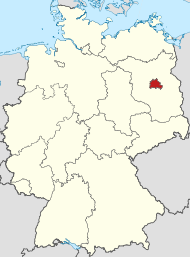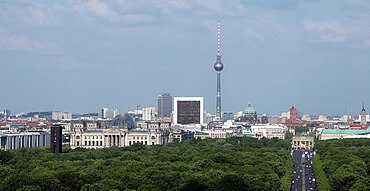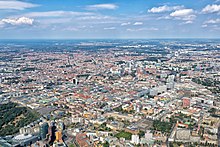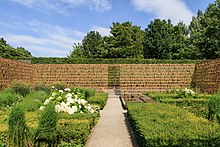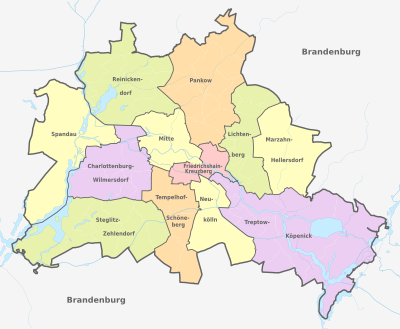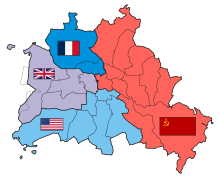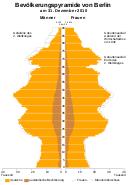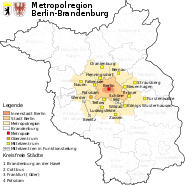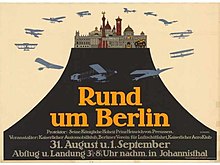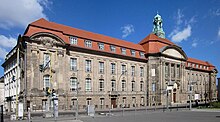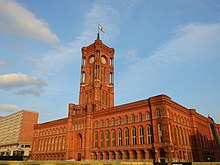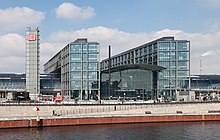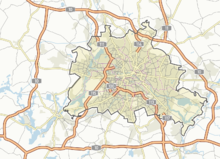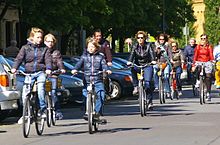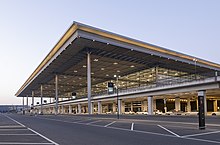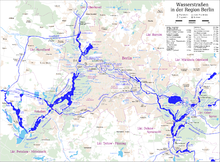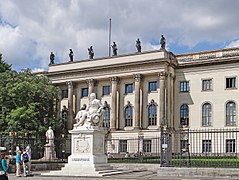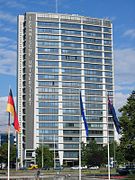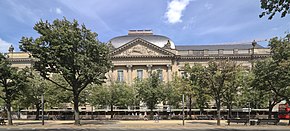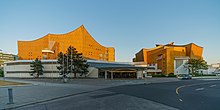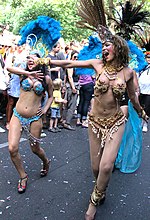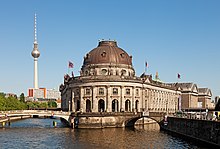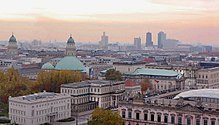Berlin
Berlin ( [ bɛɐ̯ˈliːn ] ) is the capital and a country of the Federal Republic of Germany . The city has approximately 3.7 million inhabitants the most populous with 892 square kilometers, the area's largest community of Germany and the most populous city in the European Union . With 4108 inhabitants per square kilometer, the city has the third highest population density in Germany. In agglomeration Berlin live almost 4.7 million inhabitants in the capital region of Berlin-Brandenburg 6.2 million. The city-state consists of twelve districts . In addition to the rivers Spree and Havel, there are smaller rivers and numerous lakes and forests in the urban area.
First mentioned in a document in the 13th century , Berlin was the capital of the Mark Brandenburg , Prussia and Germany in its history . After the end of the Second World War, the city was subject to four-power status in 1945 ; From 1949 East Berlin functioned as the capital of the German Democratic Republic , while West Berlin was closely associated with the old Federal Republic of Germany. With the fall of the Berlin Wall in 1989 and German reunification in 1990, the two halves of the city grew together again and Berlin regained its role as the German capital. Since 1999, the city has been the seat of the federal government , the Federal President , the German Bundestag , the Bundesrat, as well as most federal ministries , numerous federal authorities and embassies .
Among the most important branches of the economy of Berlin include the tourism , the creative and cultural industries , the biotechnology and healthcare industry with medical and pharmaceutical industry , the information and communication technologies , the construction and real estate industry , the trade , the optoelectronics , the energy technology and the trade fair and congress industry . The city is a European transport hub for rail and air traffic . Berlin is one of the up-and-coming international centers for innovative company founders . Berlin records high annual growth rates in the number of people in employment .
Berlin is known as a cosmopolitan city of culture , politics , media and science . The local universities and research institutions , local sports and museums enjoy an international reputation. The metropolis bears the UNESCO title City of Design and is one of the most visited centers on the continent. Architecture , festivities and nightlife are known around the world.
geography
position
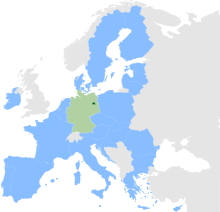
Berlin's distinctive reference point, the Red City Hall , has the geographical location : 52 ° 31 ′ 7 ″ north latitude, 13 ° 24 ′ 30 ″ east longitude, the center of gravity of the city is around two kilometers south of it in Kreuzberg ( 52 ° 30 ′ 10, 4 " N , 13 ° 24 '15.1" E ). The largest expansion of the urban area in east-west direction is around 45 kilometers, in north-south direction around 38 kilometers. The area of Berlin is almost 892 km². The city is located in the northeast of the Federal Republic of Germany and is completely surrounded by the state of Brandenburg .
The historical center is located at the narrowest and therefore most easily accessible point of the Warsaw- Berlin glacial valley , which crosses Berlin from the south-east to the north-west and is traversed by the Spree in an east-west direction. The north-eastern part of Berlin lies on the Barnim plateau , almost half of the urban area in the south-western area is on the Teltow plateau . The westernmost district , Spandau , is spread across the Berlin glacial valley, the Brandenburg-Potsdamer Havel area and the Zehdenick-Spandau Havel lowlands . The landscape of Berlin was created in the Ice Age during the most recent glaciation phase, the Vistula Ice Age . About 20,000 years ago the area of Berlin was covered by the Scandinavian ice sheet ( glacier ) several hundred meters thick . When the glacier melted back, the Berlin glacial valley was created around 18,000 years ago.
Waters and elevations
Berlin has numerous rivers and lakes. The Spree flows into the Havel in Spandau , which flows through the west of Berlin in a north-south direction. Berlin tributaries of the Spree are the Panke , Dahme , Wuhle and Erpe . The course of the river Havel, actually a glacial channel , often resembles a lake landscape; the largest bulges are the Tegeler See and the Große Wannsee . The Tegeler Fließ and Bäke brooks that flow into the Havel are partly located in Berlin . The largest lake in Berlin is the Große Müggelsee in Treptow-Köpenick .
In Berlin, 13 water protection areas on an area of around 212 km² are designated by water protection area ordinances. In relation to the total city area of around 890 km², around a quarter of the city area is designated as water protection areas.
The highest elevations in Berlin are the highest natural ground elevation of the Great Müggelberg ( 115 m above sea level. NHN ) in the district of Treptow-Koepenick , incurred from construction waste Arkenberge ( 122 m above sea level. NHN ) in the district of Pankow , who made rubble of World War II heaped Teufelsberg ( 120 m above sea level ) in the Charlottenburg-Wilmersdorf district and the Ahrensfeld mountains ( 114 m above sea level ) in the Wuhletal landscape park in the Marzahn-Hellersdorf district . The lowest point in Berlin is at ( 28.1 m above sea level ) on the Spektesee in the Spandau district.
Forests and parks

In addition to extensive forest areas in the west and south-east of the urban area ( Berlin Forests ), Berlin has many large parks. Since almost all streets are lined with trees, Berlin is considered a particularly green city. There are around 440,000 street trees in Berlin, including 153,000 linden trees , 82,000 maples , 35,000 oaks , 25,000 plane trees and 21,000 chestnuts . The more than 2500 public green, recreational and park facilities have a total area of over 5500 hectares and offer a wide range of leisure and recreational opportunities. The largest facility in Berlin, now known as a park , is the Tempelhofer Park , which was created on the former Tempelhof Airport .
The Great Zoo is located in the center of the city . It is the oldest and, at 210 hectares, the second largest and most important park in Berlin, and was designed over the course of more than 500 years. Originally an extensive forest area in front of the city gates, used by the Prussian nobles as a hunting and riding area, this was gradually enclosed by the urban development. Today it stretches from the Zoo train station to the Brandenburg Gate and borders directly on the government district . Several major roads cut through the Tiergarten, including Strasse des 17. Juni as an east-west axis. They cross at the Großer Stern , in the middle of which the Victory Column has stood since 1939 . The Great Zoo has the shape of a natural park landscape : Characteristic are the wide lawns with small watercourses and clusters of trees as well as the lakes with small islands and numerous bridges and avenues. Areas such as the English Garden , the Luiseninsel and the Rosengarten add jewelery gardening accents in some places.
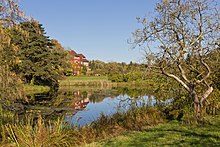
In addition to the Tiergarten, Treptower Park in southeast Berlin is one of the city's most important parks. It was laid out from 1876 to 1882 by the first Berlin horticultural director Gustav Meyer . The vast garden landscape stretching along the Spree is one of the most popular excursion destinations for Berliners, not least because of the Zenner restaurant, which was built by Carl Ferdinand Langhans as an inn on the Spree in 1821/1822 .
A special feature among the parks is the botanical garden . Located in the southwest of the city, it is used as a recreational park in addition to its scientific purpose (it belongs to the Free University of Berlin ). The previous facility had existed since 1697 on the site of today's Kleist Park in Schöneberg . From 1897 the construction of the new park in Dahlem and Groß-Lichterfelde took place . According to the Greater Berlin Act of 1920 and the regional reform of 1938 , the Botanical Garden is now located in the Lichterfelde district . With an area of over 43 hectares, it is the fourth largest botanical garden in the world. It includes around 22,000 different plant species. The 25 meter high, 30 meter wide and 60 meter long Large Tropical House is the tallest greenhouse in the world.
Other parks in Berlin are the palace gardens in Charlottenburg , Glienicke and on Pfaueninsel (the last two are UNESCO World Heritage Sites ), the historic Lustgarten , Viktoriapark , Rudolph-Wilde-Park and Schillerpark and the numerous large public gardens . The Federal Horticultural Show took place in the Britz Garden in 1985 , and the Berlin Garden Show in 1987 in what is now the Gardens of the World . The International Horticultural Exhibition took place there in 2017 . The Mauerpark on the former death strip of the Berlin Wall , the nature reserve Schöneberger Südgelände , Görlitzer Park and Spreebogenpark are among the younger parks in Berlin.
Zoos and protected areas
Berlin has several zoological facilities : the zoological garden with aquarium and the zoo . The zoological garden, which opened in 1844 on what was then the city limits of Charlottenburg , is the oldest zoo in Germany and at the same time the most species-rich in the world (around 15,000 animals in 1,500 species). The much younger zoo owes its creation to the division of Germany after 1945: Because the zoological garden was in the British sector of the city, the GDR capital lacked its own zoo. In 1954, a zoo was opened in Friedrichsfelde under the direction of Heinrich Dathe on the grounds of the Friedrichsfelde Palace Park . With 160 hectares, it is the largest landscape animal park in Europe.
In Berlin there are 43 nature reserves (as of 2018) with a total area of 2668 hectares, which corresponds to around 3.0 percent of the state's area. In addition, there are 56 protected landscape areas , which take up a further 14 percent of the country's area. In addition, the districts of Pankow and Reinickendorf have an area share of 5.4 percent in the transnational, 75,000 hectare Barnim Nature Park .
climate
The city is located in the temperate climate zone at the transition from the maritime to the continental climate. Since the beginning of the 20th century, mean annual temperatures have fluctuated - with an upward trend - between 7 ° C and 11 ° C. The average annual temperature in Berlin-Dahlem is 9.5 ° C and the average annual rainfall is 591 mm. The warmest months are July and August with an average of 19.1 and 18.2 ° C, respectively, the coldest is January with an average of 0.6 ° C. The previous maximum temperature in Berlin of 38.9 ° C was measured on August 7, 2015 at the Kaniswall station . Most of the precipitation falls in August with an average of 64 mm, the lowest in April with an average of 33 mm (all mean values from 1981 to 2010 from the German Weather Service ).
With regard to the wind speeds and the wind direction distribution, a two-part maximum can be recorded. According to this, north-west and south-west winds are most frequently observed in Berlin, which are associated with higher speeds, especially in winter, and mostly transports maritime , well-mixed and clean sea air. The second maximum from the south-east and east is often indicative of high-pressure weather conditions of continental air masses, which, depending on the season, can lead to relatively hot or cold days.
| Berlin | ||||||||||||||||||||||||||||||||||||||||||||||||
|---|---|---|---|---|---|---|---|---|---|---|---|---|---|---|---|---|---|---|---|---|---|---|---|---|---|---|---|---|---|---|---|---|---|---|---|---|---|---|---|---|---|---|---|---|---|---|---|---|
| Climate diagram | ||||||||||||||||||||||||||||||||||||||||||||||||
| ||||||||||||||||||||||||||||||||||||||||||||||||
|
Average monthly temperatures and precipitation for Berlin
Source: DWD, data: 1971–2000
|
|||||||||||||||||||||||||||||||||||||||||||||||||||||||||||||||||||||||||||||||||||||||||||||||||||||||||
The small height differences within the city actually result in a more homogeneous urban climate , but the dense development in the city and the district centers leads to sometimes significant temperature differences compared to large inner-city open spaces and above all to the extensive agricultural areas in the surrounding area. Temperature differences of up to 10 ° C are measured, especially on summer nights. Overall, however, Berlin also benefits from its large proportion of green space in this context: more than 40 percent of the urban area is green; In 2012 "439,971 trees lined the streets". The large number of smaller open spaces, but especially the inner-city green spaces such as the Große Tiergarten , the Grunewald and the former Tempelhof Airport with the neighboring Hasenheide create a cooling effect and are therefore also referred to as "cold islands".
City structure
The administration of the State of Berlin is carried out by the Senate of Berlin (the main administration) and the twelve district administrations. The main administration takes on the tasks of the city as a whole and includes the senate administrations, the subordinate authorities (special authorities) and non-legal institutions as well as the own operations under their supervision.
Since Berlin is a unified municipality , the districts are not independent municipalities , but measured in terms of population they are comparable to larger rural districts in large states . The districts are subject to district supervision by the Senate. In each district there is a district council assembly (BVV). This elects the district office, consisting of the district mayor and four city councilors , according to party proporz . The district mayor is provided by the largest parliamentary group or a larger counting community of several parliamentary groups. District mayors and city councilors have electoral officer status despite their quasi-political election . The mayors of the districts form the Council of Mayors , chaired by the Governing Mayor , which advises the Senate.
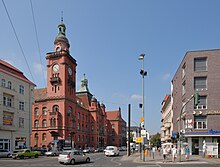
The structure and tasks of the Berlin administration result from the General Competence Act (AZG). The structure and tasks of the Berlin district administration are specified in more detail in the District Administration Act (BezVwG). Since 1990 an administrative reform has been carried out in Berlin in stages .
The administrative structures and authorities of the city-state are currently (as of 2016/17) both within Berlin and throughout Germany classified as working too slowly and in need of modernization.
According to the Berlin constitution, Berlin is divided into twelve districts. These are in turn divided into 97 districts (as of 2021), with the state constitution only dividing them into districts. The districts do not represent administrative units, but form the basis of official location information and therefore also have administrative boundaries.
With the Greater Berlin Act in 1920, eight cities as well as 59 rural communities and 27 manor districts were combined. The new Greater Berlin originally comprised 20 districts with 94 districts at the time, which, with unchanged borders, corresponded to the previous divisions. After the division of the city, twelve of these 20 districts were in West Berlin and eight in East Berlin.
On the occasion of the creation of new development areas on the eastern edge of the city - without incorporation - the number of districts in East Berlin was increased to eleven by spin-offs between 1979 and 1986. The division in West Berlin remained unchanged (except for an area swap in 1945 , when the eastern part of Groß Glienicke came to Berlin in exchange for West Staaken and became the 95th district).
In 1990, the reunified Berlin initially had 23 districts, the number of which was finally reduced to twelve in 2001 through district mergers as part of a regional reform. The number and layout of the districts have also changed several times over the past few decades.
| No. | District of Berlin | resident |
Area in km² |
Inhabitants per km² |
|---|---|---|---|---|
| 1. |
|
383.360 | 39.47 | 9,733 |
| 2. |
|
289,787 | 20.34 | 14,246 |
| 3. |
|
410.716 | 103.07 | 3,956 |
| 4th | 341,392 | 64.72 | 5,289 | |
| 5. |
|
245,527 | 91.87 | 2,656 |
| 6th |
|
308.840 | 102.56 | 3,010 |
| 7th |
|
349,539 | 53.10 | 6,622 |
| 8th. |
|
327.945 | 44.93 | 7,338 |
| 9. |
|
276.165 | 168.42 | 1,610 |
| 10. |
|
273.731 | 61.78 | 4,347 |
| 11th |
|
296,837 | 52.12 | 5,592 |
| 12th |
|
266.123 | 89.31 | 2,970 |
| 3,664,088 | 891.68 | 4,088 |
- ↑ The population for Berlin as a whole comes from the population update based on the 2011 census (this is the official population for Berlin), while the district numbers are from the city's population register. The total of the residents of the districts can therefore differ from the population for the entire city.
story
Origin of name and first settlements
The name Berlin is originally Slavic . It goes back to the old Polish Birlin, Berlin and means 'place in a swampy area'. Lake Berl in Berlin-Wartenberg still exists today. It is based on old Polish birl-, berl- 'swamp, morass', supplemented by the place name-forming Slavic suffix -in . The documented tradition with the article ("der Berlin") speaks for an original field name that was taken up by the settlers. Like all Slavic German place names in north-eastern Central Europe that end in -in ( Schwerin , Stettin , Eutin , Templin , Küstrin , etc.), Berlin is also stressed on the last syllable.
The name Kölln is probably a name transfer from Cologne on the Rhine, which goes back to the Latin colonia , planting city in a conquered land, colony. However, a derivation from an Old Polish name * kol'no, which would become kol 'stake', cannot be completely ruled out .
The city name can neither be traced back to the alleged founder of the city, Albrecht the Bear , nor to the Berlin heraldic animal . This is a talking coat of arms with which an attempt is made to depict the city name in a German interpretation. The heraldic animal is therefore derived from the city name, not the other way around.
Margraviate and Electorate of Brandenburg

The town of Kölln , located on the Spree island , was first mentioned in a document in 1237. In 1244 (Old) Berlin was mentioned, which is located on the northeast bank of the Spree. Recent archaeological finds show that there were suburban settlements on both sides of the Spree as early as the second half of the 12th century. In 1280 the first provable Brandenburg state parliament took place in Berlin. This points to an early top position, as can also be seen in the land book of Charles IV (1375), when Berlin with Stendal , Prenzlau and Frankfurt / Oder are shown as the cities with the highest tax revenue. The two cities of Berlin and Kölln got a joint town hall in 1307.
Berlin shared the fate of Brandenburg among the Ascanians (1157–1320), Wittelsbachers (1323–1373) and Luxemburgers (1373–1415). In 1257, the Margrave of Brandenburg was the only electoral college entitled to vote for a king for the first time. The exact rules were laid down in 1356 with the Golden Bull ; since then Brandenburg was considered an electorate. After the German King Sigismund of Luxemburg enfeoffed Friedrich I of Hohenzollern with the Mark Brandenburg in 1415, this family ruled Berlin as margraves and elector of Brandenburg until 1918 and from 1701 also as kings in and of Prussia .
From the 14th century Berlin was a member of the Hanseatic League. In 1518 Berlin formally withdrew from the Hanseatic League or was excluded from it.
1448 revolted citizens of Berlin in " Berlin indignation " against the castle construction of the Elector Friedrich II. ( "Iron Teeth"). This protest was unsuccessful, however, and the city forfeited many of its now- obsessed political and economic freedoms. In 1486, Elector Johann Cicero declared Berlin the main city of residence of the Brandenburg Electorate.

The Reformation was introduced in Berlin and Kölln in 1539 under Elector Joachim II , without any major disputes. The Thirty Years' War between 1618 and 1648 had devastating consequences for Berlin: a third of the houses were damaged and the population halved. Friedrich Wilhelm , known as the Great Elector, took over government from his father in 1640. He started a policy of immigration and religious tolerance. From the following year the suburbs Friedrichswerder , Dorotheenstadt and Friedrichstadt were founded .
In 1671 50 Jewish families from Austria were given a home in Berlin. With the Edict of Potsdam in 1685, Friedrich Wilhelm invited the French Huguenots to Brandenburg. Over 15,000 French came, 6,000 of whom settled in Berlin. By 1700, 20% of Berlin's residents were French and their cultural influence was great. Many immigrants also came from Bohemia , Poland and Salzburg . From 1658 to 1683 the twin cities of Berlin-Kölln were expanded into a fortress with a total of 13 bastions .
Prussia and the German Empire

With the coronation of Frederick I as king in Prussia in 1701, Berlin achieved the status of the Prussian capital, which became official on January 17, 1709 through the edict to form the Royal Residence Berlin by amalgamating the cities of Berlin, Kölln, Friedrichswerder, Dorotheenstadt and Friedrichstadt. The population of Berlin rose to around 55,000. Soon afterwards new suburbs emerged , which enlarged Berlin. Around 1800 the city developed into one of the centers of the German cultural landscape, which was expressed in the metropolitan civic culture known as the “ Berlin Classic ”.
After the defeat of Prussia in 1806 against the armies of Napoleon , King Friedrich Wilhelm III left. Berlin towards Königsberg . Authorities and wealthy families moved away from Berlin. French troops occupied the city from 1806 to 1808. Under the reformer Freiherr vom und zum Stein , the new Berlin city order was passed in 1808 , which led to the first freely elected city council . A mayor was elected to head the new administration . The swearing-in of the new city administration, called Magistrat , took place in the Berlin City Hall .
The formation of a Berlin university, proposed by Wilhelm von Humboldt , played an important role in the reforms of schools and academic institutions . The new university (1810) quickly developed into the intellectual center of Berlin and soon became widely famous. Further reforms such as the introduction of a trade tax, the trade police law (with the abolition of the guild order), passed under State Chancellor Karl August von Hardenberg , civil equality for Jews and the renewal of the army led to a new growth spurt in Berlin. Above all, they laid the foundation for the later industrial development in the city. The king returned to Berlin at the end of 1809. On May 28, 1813, death sentences by burning at the stake were carried out for the last time in Prussia in Jungfernheide .
In the following decades, up to around 1850, new factories were established outside the city walls, in which the immigrants found employment as workers or day laborers. As a result, the number of residents doubled due to immigration from the eastern parts of the country. Important companies such as Borsig , Siemens or AEG emerged and soon led to Berlin being regarded as an industrial city. This was accompanied by the political rise of the Berlin labor movement , which developed into one of the strongest in the world.
As a result of the March Revolution , the king made numerous concessions. In 1850, a new city constitution and municipal code were adopted, according to which the freedom of the press and freedom of assembly were repealed, a new three-class suffrage was introduced and the powers of city councilors were severely restricted. The rights of Police President Hinckeldey , however, have been strengthened. During his tenure until 1856, he took care of the development of the city's infrastructure (especially city cleaning, waterworks, water pipes, and the construction of bathing and washing facilities).
In 1861 Moabit and Wedding as well as Tempelhofer , Schöneberger , Spandauer and other suburbs were incorporated. The Hobrecht Plan regulated the expansion of the city from 1862 onwards . The block development with an eaves height of 22 meters characterizes many of Berlin's city districts. The rapid increase in population, building speculation and poverty resulted in precarious living conditions in the tenements of the emerging workers' residential quarters with their narrow, multi-tiered backyards typical of Berlin.
When the Prussian Prime Minister Otto von Bismarck agreed to form a small German nation-state on January 18, 1871, Berlin became the capital of the German Empire (until 1945). After the emergence of the empire , the founding period followed , in which Germany rose to become a world power and Berlin became a cosmopolitan city . Berlin first became a city of millions in 1877 and exceeded the two-million-inhabitant limit for the first time in 1905. The four decades of peace ended with the beginning of World War I in 1914. After the defeat of Germany in 1918, Kaiser Wilhelm II did not return to Berlin. He fled to the Netherlands .
Weimar Republic and Greater Berlin
After the end of the First World War , the Republic was proclaimed in Berlin on November 9, 1918 . In the months after the November Revolution , there were several clashes, some of them bloody, between the government and its voluntary corps and revolutionary workers. The January uprising rocked the city in early 1919, followed by a general strike two months later . During the March fighting in Berlin , field guns, mortars and airplanes with bombs were used against the population on the orders of the Social Democratic Reichswehr Minister Gustav Noske . A total of 1200 people died in Lichtenberg from March 3rd to 16th.
In 1920 there was a bloodbath in front of the Reichstag and later the Kapp Putsch . In the second half of the year, the founding of Greater Berlin saw the largest incorporation in the city's history, in which Berlin, which existed up to that point, merged with several surrounding cities and rural communities as well as numerous manor districts to what is now known as "Berlin". The enlarged city had around four million inhabitants and was the largest city in continental Europe in the 1920s and the third largest city in the world after London and New York . This went hand in hand with a great departure for the future. In the years that followed, the city experienced a heyday of art, culture, science and technology and, due to the incorporation of the industrially rich suburbs, became the largest industrial city in Europe in the statistics in 1920. This era was later also known as the " Golden Twenties ", which came to an abrupt end with the global economic crisis at the end of the decade, also in Berlin.
National Socialism

After the " seizure of power " by the National Socialists in 1933, Berlin initially gained in importance again as the capital of the Third Reich , above all due to the centralization that was associated with the " synchronization " of the state governments. Adolf Hitler and Albert Speer developed architectural concepts for the reconstruction of the city to become the “ world capital Germania ”, but these were never realized.
The Nazi regime destroyed Berlin's Jewish community , which before 1933 had around 160,000 members. After the November pogroms of 1938 , thousands of Berlin Jews were deported to the nearby Sachsenhausen concentration camp . Around 50,000 of the 66,000 Jews still living in Berlin were deported to ghettos and labor camps in Litzmannstadt , Minsk , Kaunas , Riga , Piaski or Theresienstadt from 1941 onwards. Many died there under the adverse living conditions, others were later deported to extermination camps such as Auschwitz and murdered during the Holocaust .
During the Second World War , Berlin was first attacked by British bombers on August 25, 1940 . The Allied air raids increased massively from 1943, with large parts of Berlin being destroyed. The Battle of Berlin in 1945 led to further destruction. Almost half of all buildings were destroyed, only a quarter of all apartments remained undamaged. Of 226 bridges, only 98 were left.
divided town
After the city was taken by the Red Army and the unconditional surrender of the Wehrmacht on May 8, 1945, Berlin was divided into four sectors in July 1945 in accordance with the London Protocols - according to the division of Germany into occupation zones. The US , UK , France and Soviet Union sectors emerged . Neither the Yalta Conference nor the Potsdam Agreement provided for a formal division into western and eastern sectors ( West Berlin and East Berlin ). This grouping arose in 1945/46, among other things, due to the common interest of the Western Allies .
The Soviet military administration in Germany created a magistrate for Berlin on May 19, 1945 . It consisted of an independent mayor, four deputies and 16 city councilors. For Greater Berlin , however, all four victorious powers had overall responsibility . The increasing political differences between the Western Allies and the Soviet Union led to an economic blockade in West Berlin after a currency reform in the Western sectors in 1948/1949 , which the Western Allies overcame with the " Berlin Airlift ".
With the establishment of the Federal Republic of Germany in western Germany and the German Democratic Republic (GDR) in eastern Germany in 1949, the Cold War also solidified in Berlin. While the Federal Republic established its seat of government in Bonn , the GDR proclaimed Berlin as its capital. Since 1949 West Berlin was de facto a state of the Federal Republic with a special legal position and East Berlin was de facto part of the GDR. The East-West conflict culminated in the Berlin crisis and led to the construction of the Berlin Wall by the GDR on August 13, 1961.
On June 26, 1963, American President John F. Kennedy visited the divided city.
The east and west of the city have been separated from each other since then. The transition was only possible at certain checkpoints, but no longer for residents of the GDR and East Berlin and until 1972 only in exceptional cases for residents of West Berlin who were not only in possession of a Berlin ID card.
In 1972 the four power agreement on Berlin came into force. While the Soviet Union only applied the four-power status to West Berlin, the Western powers underlined their view of the four-power status of the whole of Berlin in a note to the United Nations in 1975 . The problem of the controversial status of Berlin is also known as the Berlin question .
In 1989 there was a political turning point in the GDR , the wall was opened on November 9th.
Reunited city
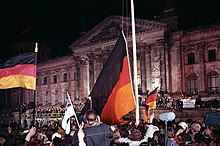
On October 3, 1990, the two German states were united by the accession of the GDR to the scope of the Basic Law for the Federal Republic of Germany , and Berlin became the capital city by means of a unification treaty . In 1994 the troops of the former occupying powers finally withdrew from Berlin.
On June 20, 1991, the Bundestag decided with the capital city resolution after a controversial public discussion that the city should be the seat of the German Federal Government and the Bundestag. In 1994, on the initiative of Richard von Weizsäcker, Bellevue Palace became the first official residence of the Federal President . In the period that followed, the office of the Federal President was set up in the immediate vicinity. In 1999 the government and parliament resumed their work in Berlin. In 2001 the new Federal Chancellery was inaugurated and the then Federal Chancellor Gerhard Schröder moved in. The overwhelming number of diplomatic missions in Germany relocated to Berlin in the following years.
As of January 1, 2001, the number of districts was reduced from 23 to 12 in order to enable more efficient administration and planning.
population
Population development
On December 31, 2020, Berlin had a total of 3,664,088 inhabitants, making it the most populous city in Germany. Berlin is the most populous city in the European Union within the administrative boundaries . The agglomeration of Berlin has 4.7 million inhabitants (December 31, 2019), the capital region Berlin-Brandenburg , which includes both states, around 6.2 million inhabitants.
Up until the middle of the 17th century the Berlin area was only sparsely populated; the Thirty Years' War had halved the population of Berlin again. But after Elector Friedrich Wilhelm took over the business of government from his father in 1640, he brought many Huguenots from France to the region. Thus, the population of around 6,000 rose by 1,648 to around 57,000 in 1709. The population grew steadily, so Berlin in 1747 for the city and in 1877 the metropolis was.
The increase in population in the Berlin area had accelerated as a result of the industrialization that began after the Prussian reforms . Only 40% of Berliners in the last quarter of the 19th century were born in Berlin. In 1900 more than 20% of the 1.9 million Berliners came from the Prussian provinces of Brandenburg , East and West Prussia 9%, Silesia 7%, Pomerania 6%, Poznan 5% and Saxony 4%. Immigration from other regions of Germany was rather low at three to four percent and from abroad at a good 1.5%. The proportion of Berliners with German as their mother tongue was over 98% in 1895. With the Greater Berlin Act of 1920, the population rose to almost four million through the incorporation of previously independent cities and villages. In the 1920s and 1930s, Berlin was the second largest city in the world in terms of area after Los Angeles and the third largest city in the world in terms of population after New York City and London . The population exceeded the four million mark in the 1920s and peaked at 4.48 million in 1942 (a theoretical value at the time).
The number fell again due to the Second World War and has remained constant between three and three and a half million inhabitants since then. Between 1957 and 1990, a move to West Berlin gave young men from the Federal Republic the opportunity to evade compulsory military service in the Federal Armed Forces because the Federal Republic's military legislation did not apply there. The number of arrivals and departures has been between 100,000 and 145,000 annually since 1991. The often-cited claim from 2007 that 1.7 million Berliners left the city after reunification (since 1991), 1.8 million people moved here and thus ensured an extensive exchange of people, is based on a mere addition of all immigrations and of all emigrations and exaggerates the real population fluctuation . Berlin has always had a spatial population movement that is well above average in Germany . In 2014 alone 317,151 people moved to Berlin, at the same time 275,259 residents moved from the city, which results in a positive migration balance of 41,892.
Population groups
| nationality | Citizenship of the residents |
German citizens by origin |
|---|---|---|
|
|
2,980,886 | 2,425,350 |
|
|
98,437 | 83,969 |
|
|
55.996 | 57,443 |
|
|
41,418 | 5,657 |
|
|
32,186 | 8,750 |
|
|
31,738 | 5,083 |
|
|
27,334 | 33,407 |
|
|
25,719 | 5,240 |
|
|
20,993 | 10,313 |
|
|
20,272 | 9,155 |
|
|
20,066 | 9,285 |
|
|
20,439 | 11,454 |
|
|
17,165 | 8,713 |
|
|
15,349 | 5,085 |
|
|
15,266 | 1 |
|
1 statistical values not shown
|
||
Berlin has been a migration area for Germans from German-speaking countries since the end of the 17th century at the latest . The gain in migration compared to the rest of Germany was around 18,000 people in 2009.
At the beginning of 2020, of the 3.77 million Berliners, 2.45 million were Germans without a migration background , around 777,000 foreigners and 543,000 Germans with a migration background. Thus 1.32 million people (around 35%) have foreign roots.
In the decades after 1945, many guest workers came to West Berlin from southern Europe and Turkey, and contract workers , mainly from Vietnam, came to East Berlin. Since the 1980s, many Russian-German repatriates and, since German reunification, finally, Jews from Eastern Europe, especially Ukraine and Russia , and later from Israel , made their way. Citizens from around 190 countries live in the city.
According to a study from 2015, there is a particularly high proportion of young academics among the large numbers of Europeans who immigrate to the city, at 24.3% , especially among the French, Spanish and Italians.
Kreuzberg and Neukölln are focal points of the German-Turkish population . With around 180,000 citizens of Turkish origin, Berlin is one of the largest Turkish communities outside of Turkey. In addition, around 70,000 Afro-Germans live in Berlin.
There are more than 25 groups, each with more than 10,000 people, who have a migration background.
It is estimated that between 100,000 and 250,000 unregistered immigrants live in Berlin, mainly from Africa, Asia, the Balkans and Latin America . Because of the difficulties in uniformly defining the migration background and recording it in surveys, the actual proportion of people with a migration background could deviate to a relevant extent from the figures mentioned.
Berlin wants to take in additional asylum seekers over and above the allocated quota and is organizing itself with other municipalities in the city network “Solidarity City” for this purpose.
language
The official language in Berlin is German . Berlinisch (colloquially also: Berlinerisch) is a so-called balancing dialect that emerged in Berlin as an urban center over the centuries from various linguistic influences. From a linguistic point of view , Berlinic is actually a Metrolect , an urban mix of languages that is not only of regional origin, but is also a result of a mix of dialects from different origins. As substrate there is used the low German obtained by migration from other regions, and the influence of the East Middle was gradually superimposed. However, it held, individual as "specific berlinerisch" perceived forms like det , wat , loofen , koofen (as opposed to standard German , the , what , run , buy ).
Berlinisch took numerous words and expressions from other languages and dialects such as French (settlement of Huguenots after the Thirty Years War ), Yiddish (Jewish refugees since the 16th, but especially in the 19th and 20th centuries) and Silesian / Polish (after the conquest of Silesia and the Polish partitions at the end of the 18th century). Berlinisch is spoken in Berlin and the surrounding area, and it only contains common (proverb) words or pronounced ironic expressions, the so-called " Berolinisms ".
In the area around Berlin as well as in the districts that were villages without significant contact with the capital until their incorporation, dialects of East Low German were originally spoken in Brandenburg . Since the end of the 19th century, Berlin, as a growing metropolis, had an increasingly linguistic impact on the surrounding area and the colloquial Berlin language replaced the local dialects or at least changed them considerably. In fact, today's Brandenburg is a variety of the Berlin metro ect.
In history, Berlinish was the language of the common people, the educated class mostly used a perfect standard German . Many new Berliners adopted parts of Berlinic, but the constant use was considered to be rather "crude". In the GDR, this attitude changed in part, so that Berlinerisch was sometimes cultivated in educated circles. As a result, the centers of increased use are mostly in the former eastern districts , the old western working-class districts and the surrounding area. The language in Berlin is still influenced by waves of immigrants and media-influenced language habits, which means that the colloquial language used is constantly developing.
Religions and worldviews
The 2011 census found that 21.6% of Berlin’s population belonged to the Evangelical Church , 9.6% to the Catholic Church , 1.5% to an Orthodox Church and 0.7% to an Evangelical Free Church . Overall, 37.4% of the population described themselves as Christians, 9.0% considered themselves to be of another religion or belief, 23.4% did not feel they belonged and 30.2% did not provide any information. According to a calculation from the census figures for people with a migration background, the proportion of Muslims in Berlin in 2011 was 7.6 percent (around 249,200 people), close to the figure published by the State Statistical Office for 2009 (around 249,000), whereas the BAMF - The study of Muslim life in Germany assumed around 279,800 Muslims in Berlin in 2008 (6.9 percent of around 4,055,100 Muslims in the Federal Republic of Germany).
Of the around 3.8 million Berliners at the end of 2020, 13.9% were Protestant , 8.1% Catholic and 78% belonged to other denominations and religions or none. In the eastern districts of the city, which formerly belonged to the GDR, the proportion of people with Christian ties is particularly low. In the previous year 2019, 14.4% of the residents were Protestant and 8.3% Catholic. According to studies, 250,000 to 300,000 (7–9%) people were assigned to Islamic faiths in 2018.
Several humanistic and other associations of non-religious people are represented in Berlin . The Humanist Association of Germany , whose Berlin regional association had around 7,800 members in 2012, and the Humanist Academy of Germany have their headquarters in Berlin. In 1982, the school subject Humanistic Life Studies was introduced in the western part of Berlin , with almost 62,650 students taking part in 2017.
Berlin Cathedral (Protestant)
St. Hedwig's Cathedral (Roman Catholic)
New Synagogue (Jewish)
Şehitlik Mosque (Muslim)
Bishop of the Evangelical Church Berlin-Brandenburg-Silesian Upper Lusatia is Christian Stäblein . Archbishop of Berlin and Metropolitan of the Berlin Church Province has been Heiner Koch since 2015 .
The independent Evangelical Lutheran Church , which is represented in the city with seven parishes, mostly emerged from the Evangelical Lutheran Church that was established in 1830 . These parishes belong to the Berlin-Brandenburg church district .
A Russian Orthodox and a Bulgarian Orthodox bishop are also based in Berlin, most of the other Orthodox and ancient oriental national churches are also represented with parishes.
The Anglican Community or the Church of England has a so-called "Chaplaincy" (parish), St. George's Anglican / Episcopal Church. The community has its church in Westend on Preußenallee . There is also an Old Catholic parish in Wilmersdorf , which was a guest in the Alt-Schöneberg village church , but has had its own house church near Bundesplatz since 2010 . The old Catholic and Anglican congregations are in church fellowship and celebrate joint services in St. Mary's Church .
There have been Baptists in Berlin since the middle of the 19th century, with their 36 congregations they form the largest free church in the city. Among other things, there are also 29 congregations of the New Apostolic Church . There are six wards in The Church of Jesus Christ of Latter-day Saints . The oldest Mennonite congregation in Berlin has existed since 1887.
Berlin has been the seat of the Central Council of Jews in Germany since 1999 . The Jewish Community of Berlin , the largest Jewish community in Germany, has over 12,000 members. There are over eleven synagogues , several Buddhist temples, seven mosques and 91 Islamic prayer rooms in the city. There have been Baha'i in Berlin since 1907 and they regularly take part in the interreligious dialogue in Berlin. In addition, around 7,000 Hindus live in Berlin.
Personalities
Honorary citizens are listed in the list of honorary citizens of Berlin , personalities born in the city are listed in the list of sons and daughters of Berlin , biographies of people with a clear connection to Berlin are collected in the Person (Berlin) category . The members of the Berlin state governments since 1948 can be found in the lists of Governing Mayors of Berlin and List of Senators of Berlin . Various city originals are grouped under Berlin originals .
politics
German capital
In 1991, after reunification, the German Bundestag decided in the so-called “ Capital Resolution ” that Berlin, as the federal capital, should also become the seat of the Bundestag and the federal government . The Berlin / Bonn Act is a consequence of the capital city resolution of June 20, 1991, in which Berlin was also designated as the seat of government.
The first official residence of the Federal President has been in Bellevue Palace in Berlin since 1994 . In 1999 most of the federal government moved from Bonn to Berlin. The Bundestag (in the Reichstag building ), the Bundesrat and the federal government have since started operations in the federal capital. The Federal Chancellery was inaugurated in 2001 and Federal Chancellor Gerhard Schröder moved in for the first time . The newly established headquarters of the Federal Intelligence Service was moved into in November 2018.
Of the 14 federal ministries currently in the 17th German Federal Cabinet , eight have their headquarters in Berlin. These include the Foreign Office and the Federal Ministries of Finance ; for families, seniors, women and youth ; for work and social affairs ; of the interior ; of Justice and Consumer Protection ; for business and energy ; for traffic and digital infrastructure . The other six federal ministries have their headquarters in the federal city of Bonn . All ministries, including those in the capital, have a second seat in the other city.
The federal ministries for education and research are in Berlin ; for food and agriculture ; for health ; for the environment, nature conservation, construction and reactor safety ; the defense and for Economic Cooperation and Development represented with a second seat. Around two thirds of the ministry employees, around 12,600 civil servants and collective bargaining employees (as of 2018), work in Berlin.
158 states have their German embassies in Berlin , while the 16 federal states are represented by state representations. Many of the diplomatic missions are located in the Tiergarten district .
As the seat of government of the state with the largest economy in Europe, Berlin is one of the most influential and sought-after centers of European politics. Party headquarters, trade unions, foundations, associations and corporate lobby groups are based there so that they can exert their influence on decision-making processes in parliament and government. State visits and receptions at all political levels as well as state acts and socially significant celebrations shape the annual political calendar of Berlin. The Federal Law Gazette, on the other hand, is still published in Bonn today, and not a single federal court has its seat in Berlin.
State of Berlin
From 1808 to 1935 and from 1945 to 1948, the Prussian state capital Berlin was administered by a magistrate , headed by a mayor . In the period from 1935 to 1945, according to the German municipal code, there was no magistrate. From 1948 until reunification in 1990, the divided city had a magistrate in East Berlin and a senate in West Berlin.
Today's Berlin ( country appendix code BE ) has only been a German state in terms of constitutional law since reunification . This includes exactly the city of Berlin . In addition to the Berlin state constitution of 1950, the German Basic Law also declared the state of Berlin to be a member state of the Federal Republic of Germany , but due to the reservations of the Allies , this was ineffective under international law until then . In fact, with some restrictions , West Berlin had been part of the Federal Republic of Germany since 1949, while the same had no factual effect for East Berlin, which was formally included . Article 3 of the Unification Treaty stipulates the permanent legal opinion of the Federal Republic that the Basic Law already applied in West Berlin before reunification.
legislative branch
The state parliament of the country's legislative power is to the Constitution of Berlin , the Berlin House of Representatives . It currently includes MPs from the SPD , CDU , Die Linke , Bündnis 90 / Die Grünen , AfD and FDP .
executive
The Berlin Senate , consisting of the governing mayor and ten senators , forms the state government . The governing mayor is also the head of the country and the city. The Senate administrations correspond to the ministries in the territorial states and are currently constituted as follows: Senate Administration for Finance , Senate Administration for Integration, Labor and Social Affairs , Senate Administration for Education, Youth and Family , Senate Administration for Science, Health, Nursing and Equal Opportunities , Senate Administration for Internal Affairs, Digitization and Sport , Senate Department for Justice, Diversity and Anti-Discrimination , Senate Department for Urban Development, Building and Housing , Senate Department for Economics, Energy and Enterprises , Senate Department for Culture and Europe , and the Senate Department for Environment, Mobility, Consumer and Climate Protection . The Berlin Senate has been headed by the SPD since 2001 . Since then, the party Die Linke has mostly been involved, but in some cases the CDU and Bündnis 90 / Die Grünen have also been involved .
After the election to the House of Representatives on September 26, 2021, the Senate was formed by the SPD, Greens and Left under the leadership of Franziska Giffey (SPD) as governing mayor.
The state of Berlin is divided into twelve districts .
Finances
The expenditure of the State of Berlin in 2012 amounted to 22.5 billion euros. The total debt of the State of Berlin in 2013 was around 59.8 billion euros or 57.72% of the gross domestic product . For the overall budget in 2012, the state received around 3.2 billion euros from the state financial equalization scheme and around 2.4 billion euros in supplementary federal allocations. The European Union is contributing around 850 million euros to the budget for the 2014–2020 period. In 2018, Berlin topped the list of four recipient countries with 4.4 billion euros in grants from the state financial equalization scheme.
Coats of arms and flags

The Berlin coat of arms shows in a silver (white) shield a red-armored and red-tongued, upright black bear , the so-called Berlin bear . A golden five-leaf crown of leaves rests on the shield, the forehead of which is laid out as masonry with a closed gate in the middle. The origin of the bear as a heraldic animal is unclear, there is no document or documentation on this. There are several theories why city officials chose the bear. One of them says that the Berliners thought of Albrecht the Bear , the founder of the Mark Brandenburg . Another is based on the onomatopoeic interpretation of the city's name. The bear can be seen for the first time on a seal from 1280. For several centuries the bear had to share the seal and coat of arms images with the Brandenburg and Prussian eagles . It was not until the 20th century that the Berlin bear was finally able to assert itself against the eagles as the city's emblem.
| Standard flagging (viewing direction of the state service building): | ||||

|

|

|
||
The Berlin state flag shows the Berlin bear against a white background, with a red stripe at the top and bottom of the flag. It has been run by Berlin since 1911, with minor stylistic changes, and blew over the Rotes Rathaus for the first time in 1913. Before that, Berlin ran a flag in the colors black-red-white, which was exchanged for the bear flag due to constant confusion with the flag of the German Empire that was later created. The national symbol is the bear shield without a foliage crown in three colors. It is provided by the Senate Department for Internal Affairs and Sport to enable private individuals, companies and non-sovereign institutions to document their attachment to Berlin with a symbol. The Berlin districts have their own coats of arms. As a connecting element of all Berlin districts with the city of Berlin, but also with each other, a three-tower wall crown rests on the shields, the middle tower of which is covered with the Berlin coat of arms (silver).
Town twinning
The State of Berlin maintains the following city partnerships :
![]() Los Angeles , United States (1967) Paris , France (1987) Madrid , Spain (1988) Istanbul , Turkey (1989) Warsaw , Poland (1991) Moscow , Russia (1991) Budapest , Hungary (1991) Brussels , Belgium (1992) Jakarta , Indonesia (1993) Tashkent , Uzbekistan (1993) Mexico City , Mexico (1993) Beijing , People's Republic of China (1994) Tokyo , Japan (1994) Buenos Aires , Argentina (1994) Prague , Czech Republic (1995) Windhoek , Namibia ( 2000) London , United Kingdom (2000)
Los Angeles , United States (1967) Paris , France (1987) Madrid , Spain (1988) Istanbul , Turkey (1989) Warsaw , Poland (1991) Moscow , Russia (1991) Budapest , Hungary (1991) Brussels , Belgium (1992) Jakarta , Indonesia (1993) Tashkent , Uzbekistan (1993) Mexico City , Mexico (1993) Beijing , People's Republic of China (1994) Tokyo , Japan (1994) Buenos Aires , Argentina (1994) Prague , Czech Republic (1995) Windhoek , Namibia ( 2000) London , United Kingdom (2000)
![]()
![]()
![]()
![]()
![]()
![]()
![]()
![]()
![]()
![]()
![]()
![]()
![]()
![]()
![]()
![]()
The individual Berlin districts maintain other partnerships, often with a single district in other large cities.
Police and fire brigade
The Berlin Police (until March 2021 “The Police President in Berlin”) is the police force for the State of Berlin . The state police is divided into five local and one supra- regional directorates as well as the state criminal investigation office.
The Berlin Police has around 23,000 employees , around 16,000 of them in the police force and around 3,000 in administration. The total expenditure for internal security and the police in Berlin amounts to around 1.1 billion euros per year.
The staff of the Federal Police Directorate in Berlin , based in Oberschöneweide, is subordinate to the Federal Ministry of the Interior . The staff is responsible for the states of Berlin and Brandenburg and has around 3,700 employees (as of 2017).
The Berlin fire brigade was founded in 1851, making it the first professional fire brigade in Germany. With around 4,050 employees (as of 2016) and 34 professional fire stations, it is also the largest municipal fire service in Germany. It is supported by 58 volunteer fire brigades with around 1,400 active volunteer members and, if necessary, by the Technical Relief Organization (THW).
Judiciary
There are 15 lower regional courts and four higher regional courts in the judicial district of Berlin. Of the four locations of the higher administrative courts in Berlin, two belong to the judicial district of the states of Berlin and Brandenburg.
The Constitutional Court of the State of Berlin has existed since 1990. In 2020, the state had eight penal institutions.
business
In 2019, the nominal gross domestic product (GDP) of the state of Berlin was 153.3 billion euros. In terms of nominal GDP, Berlin is the largest urban economy in Germany and the third largest within the European Union.
Between 2009 and 2019, the gross domestic product rose by an annual average of 4.5%, compared to 3.5% nationwide. In 2019, the GDP per capita in the state of Berlin was 41,967 euros and was above the national German average for the first time since 1990. The number of people in employment in Berlin was around 2.064 million in the same year. That was 2.4% more than in the previous year.
According to the 2019 Social Report by the Statistical Office, 16.5% of the population in Berlin were at risk of poverty . In contrast, 9.1% of the population lived above the wealth line in income wealth . In 2016 there were 489 millionaires living in Berlin. By 2019 this number had increased by more than 50% to 749 millionaires in the whole of Berlin.

The most important branches of industry in Berlin are the creative and cultural industries, tourism, biotechnology, medical technology, pharmaceutical industry, media / information and communication technology, construction, retail, traffic systems technology, optics and energy technology. Around 80% of Berlin’s total economic output is provided by the service sector.
The main location factors of the Berlin-Brandenburg capital region include the renowned university and research landscape, the cultural attractiveness of the metropolis, a large number of academically trained employees, the proximity to the seat of government of the Federal Republic of Germany, the international fame of the metropolis, and access to venture capitalists as well as the highly differentiated local transport infrastructure and medical care. In various international studies and rankings, the quality of life in Berlin is also rated as very above average.
One of the biggest problem areas in Berlin's economy is the birth rate, which is too low by international standards, and the high degree of childlessness in large parts of the population. In the medium and long term, this could lead to an increasing shortage of skilled workers and a loss of innovative capacity. In the Future Atlas 2019 , the city of Berlin was ranked 93rd out of 402 districts, municipal associations and independent cities in Germany. According to the report, Berlin's greatest strength is the city's high level of dynamism, while the comparatively low level of added value is its greatest weakness.
company
Of the 40 German companies listed in the DAX , Delivery Hero SE, Deutsche Wohnen SE, Siemens AG (shared with Munich), Zalando and Hello Fresh have nominal headquarters in Berlin. Berlin is currently the city with the second most DAX companies in Germany after Munich. In addition, the DAX member Siemens Energy SE has relocated its corporate management in Berlin. Deutsche Bahn AG, with its Berlin headquarters, ranks 232 among the top-selling companies in the world ( Fortune Global 500 ) in 2020. Of the 50 MDAX companies, AUTO1 Group SE, HelloFresh SE, and Zalando SE will have their headquarters in Berlin in 2021 . In the same year, three other Berlin companies were listed on the SDAX . Other well-known Berlin companies are Axel Springer SE and Rocket Internet SE. The family business with the highest turnover in Berlin is the confectionery manufacturer August Storck .
After 2000, Berlin recorded a very above-average start-up activity in a German and European comparison. New companies have been established in a variety of industries. Both German and international young entrepreneurs realized their business models in Berlin. In 2015, 41,400 companies were created. In relation to 10,000 inhabitants, there were 29 new businesses in Berlin (national average: four). Due to the dynamism of newly created companies, Berlin is counted among the ten outstanding start-up locations worldwide. In 2019, 60 percent of the capital invested in Germany was invested in Berlin companies. In 2019, the Berlin start-up companies, with 3.5 billion euros, made comparatively most of the venture capital across Germany.

| rank | Surname | Headquarters | Employee in Berlin |
Branch of industry |
|---|---|---|---|---|
| 1. | Deutsche Bahn | Berlin | 20,770 | Transport / logistics |
| 2. | Charité | Berlin | 17,527 | Bless you |
| 3. | Vivantes | Berlin | 16,136 | Bless you |
| 4th | Berlin transport company | Berlin | 14,589 | traffic |
| 5. | Siemens | Berlin / Munich | 11,600 | Electrical engineering |
| 6th | Edeka | Hamburg | 10,625 | trade |
| 7th | Daimler | Stuttgart | 10,200 | automobile |
| 8th. | Deutsche Post DHL | Bonn | 10,000 | logistics |
| 9. | Deutsche Telekom | Bonn | 8,000 | telecommunications |
| 10. | Zalando | Berlin | 7,300 | Digital economy |
The strong presence of well-known companies in Berlin cannot hide the fact that the city's economy has lost a considerable amount of industrial jobs in recent decades as a result of company closings and relocations (e.g. General Electric, Philip Morris, Daimler, Samsung and others) . In the 1990s and 2000s in particular, numerous jobs were cut in the manufacturing sector. In the years after reunification, around three quarters of industrial jobs were lost, although the trend reversed in the 2010s. The relative share of jobs in the manufacturing industry is nonetheless significantly lower than in other major German cities.
tourism

Berlin is one of the most visited centers of national and international city tourism . In 2016, around 31 million overnight stays in Berlin accommodation providers were counted with over 12.7 million guests. Compared to 2001 (11.3 million overnight stays by 4.9 million guests), this represents an increase of around 250%. This makes the city a preferred travel destination within Europe after London and Paris .
In 2015, the Berlin accommodation landscape consisted of 814 accommodations with a bed capacity of around 136,000 and an average occupancy of 60.5%. The length of stay of the hotel guests averages 2.4 days. International guests make up around 40% of the number of visitors. Visitors from the United Kingdom , Italy , the Netherlands , Spain and the United States are in the top group. The main attractions are architecture, historical sites, museums, festivities, shopping, nightlife and major events that attract hundreds of thousands of visitors each year.
Due to the positive development, the tourism industry in Berlin has become an important pillar of the regional economy. In addition to the hotel and catering industry, the retail sector also benefits to a large extent from Berlin tourists.
Exhibition and congress industry
Berlin is one of the world's most popular and best-selling exhibition and congress locations. In 2011 around 115,700 events with around 9.7 million participants were held. According to ICCA statistics, based on the number of congresses with international participation in 2015, Berlin is listed in first place of all congress cities.
The exhibition center in the Westend district of the Charlottenburg-Wilmersdorf district around the radio tower was opened in 1921 with an automobile exhibition, at that time in a single exhibition hall, and has a hall exhibition area of 160,000 square meters and an open area of around 100,000 square meters. The operator is the 99% city-own event organizer, Messe Berlin .
A large number of internationally relevant leading trade fairs have been established at the Berlin Exhibition Center (Berlin ExpoCenter City) and at the Berlin ExpoCenter Airport in Brandenburg. These include the consumer electronics fair IFA , the tourism exchange ITB , the aerospace show ILA Berlin Air Show , the rail traffic fair InnoTrans , the agricultural show Green Week , the food fair Fruit Logistica and the trade fair for erotic & adult entertainment Venus Berlin . The European Film Market takes place during the Berlinale in the Martin-Gropius-Bau .
The congress industry, which includes international, national and local conferences, information events and all kinds of business meetings, is another branch of Berlin’s economy. A large number of hotels are set up for conferences and thus achieve an important part of their annual turnover.
Health economy
With a gross value added of 10.7 billion euros in 2009 or a value added share of over 13% in the overall urban economy, the healthcare industry is one of the growth engines of Berlin. It includes health and social services, the pharmaceutical industry, specialist, retail and wholesale trade and medical technology. The health and social services have by far the largest share (66%) of gross value added.
A total of 226,000 people, that is 14% of the workforce in Berlin, are employed in the health industry. 79% of them work in the health and social sector and just under 6% each in manufacturing and retail.
The Berlin-Brandenburg capital region is one of the leading biotechnology locations in Europe. Around 200 small and medium-sized biotechnology companies and over 20 pharmaceutical companies with around 3700 employees are active in production, research and development in Berlin-Brandenburg.
Creative industries
Berlin is one of the leading locations for the information and creative industries in Europe. The economic sector includes the book and press market, software development, telecommunications services, the advertising market, market research, the film and broadcasting industry, the art market, the music industry, the architecture industry, the design industry and the performing arts market .
The creative and cultural industry is an important location and economic factor in Berlin and is growing continuously. In 2017, over 41,000 mostly small and medium-sized companies with around 202,000 employees generated sales of 25.7 billion euros and thus achieved a share of over 15% of the total sales of the Berlin economy. The software / games / information and communication technology sector, the book and press market, and the film and broadcasting industries represented the largest sales drivers.
The textile and fashion industry also has an important location in Berlin. In total, there are over 2,500 companies in Berlin with more than 22,000 employees in the fashion industry (as of 2017). Its main event is the Berlin Fashion Week , which takes place annually in January and July, with a large number of accompanying fashion fairs.
In Europe, Berlin is one of the leading centers of the Internet industry. In the European city ranking in 2015, the metropolis took first place in terms of investments in the industry, ahead of London , Stockholm and Paris .
media

A large number of television broadcasters, radio stations, publishers, film companies, music labels, print media, advertising agencies, producers of computer games, press services, social networks and internet media are based in Berlin.
More than 20 news agencies from around the world have offices in the city, including dpa , Thomson Reuters , AFP and ANSA . The public broadcaster rbb and the private broadcasters TV Berlin and Welt are based in Berlin. Most German national broadcasters like Das Erste , ZDF or RTL operate studios and editorial buildings. TV producers like Deutsche Welle have branches in the city. More than 30 radio stations with local and national coverage broadcast their programs from Berlin.
With 151 publishers in 2016, Berlin is one of the most important publishing locations in Europe. Axel Springer SE is one of the largest European media groups in terms of sales . The education and science publishers Walter de Gruyter , Cornelsen Verlag and the internationally active Springer Nature Group are based in the city. The important public publishers include, among others. the Berliner Verlag , the Aufbau-Verlag and the Suhrkamp Verlag .
In no other German-speaking city appear more daily newspapers and their internet portals. The picture and the world are among the most popular national daily newspapers . The taz should also be mentioned here, probably the largest newspaper operated as a cooperative . Daily local newspapers and their Internet branches are the Berliner Zeitung , the Berliner Morgenpost and Der Tagesspiegel . There are also the local tabloids BZ and the Berliner Kurier and city magazines such as tip and the English-speaking Exberliner in Berlin . The magazines produced in Berlin include the Focus , Cicero and Capital .
Due to the high concentration of producers from the media and entertainment industry in the city, Berlin was one of the ten media locations with the highest turnover in the world in 2014.
Industry
The industrial sector, which includes 333 companies with around 79,300 employees, generated sales of 23.5 billion euros in 2017. The top-selling producers in the manufacturing sector are manufacturers of chemical products (8.2 billion), the food industry (2.3 billion), mechanical and plant engineering companies (2.1 billion) and the electrical engineering industry (4.5 billion).

Founded in Berlin in 1847, Siemens operates an important location in Siemensstadt and produces gas turbines for the international market in the Mitte district. The Mercedes-Benz plant in Berlin, founded in 1902 by today's Daimler AG, is one of the largest industrial employers in Berlin with around 2500 employees. A wide variety of vehicles are manufactured in the Marienfelde plant.
The BMW plant in Berlin, which opened in Spandau in 1969, employs around 2,000 people. Around 700 motorcycles for the world market are manufactured in the plant every day.
Stadler Rail , a Swiss manufacturer of rail vehicles, operates a plant in Pankow. In Tempelhof, the baked goods manufacturer Bahlsen and Procter & Gamble produce goods for the German and European markets. The Berlin-based food manufacturer Freiberger Lebensmittel operates one of the largest pizza factories in Europe in Reinickendorf .
Trade and finance
Berlin is one of the top-selling locations for stationary retail in Europe. From international retail chains that operate representative showcase stores in Berlin , to a large number of shopping centers, to individual store concepts in lively neighborhoods, all forms of retail are represented in the city. In 2014 there were 65 shopping centers in Berlin. The KaDeWe is one of the best-known retail businesses .
Berlin is Germany's top-selling location for real estate trading. In 2015, Berlin plots and real estate worth eight billion euros were traded. The annual turnover achieved through real estate transactions in Berlin from 2007 to 2016 was between 6 and 17 billion euros. From 2007 to 2013, sales in absolute numbers and their share of nationwide sales developed in parallel. In the first year after Berlin applied the options from the Tenancy Law Amendment Act, this changed: While absolute sales continued to rise up to 2015, as in previous years, the proportion of nationwide sales fell. From 2015, when the rental price brake was introduced, absolute sales also fell.
The Berlin Stock Exchange, founded in 1695, is a regional exchange and is based in the Ludwig-Erhard-Haus . The exchange's annual turnover in 2017 was around 56 billion euros. 48 credit institutions and 25 financial service providers took part in trading.
After 2000, Berlin has developed into an important location for electronic commerce companies. The most successful dealers include Zalando , Home24 and kfzteile24 .
The main banks based in Berlin include: the German Credit Bank (DKB), a 100% subsidiary of Bayerische Landesbank and the Berliner Sparkasse , a public financial institution. The Sparkassen-Finanzgruppe , which comprises more than 600 decentralized companies in Germany in the field of financial services, is also based in the city. The Investitionsbank Berlin (IBB) is the central funding institute of the State of Berlin. The largest private banking institutions include Berlin Hyp , Weberbank , Quirin Privatbank and N26 .
Since around 2015, Berlin has been the city with the largest number of private venture capital companies in Germany. Around a quarter of all investment companies in the country are based there.
Infrastructure
The streets of Berlin are numbered according to two different house numbering systems. The circular horseshoe numbering was used until 1929, and since then the zigzag orientation numbering . As numerous Berlin streets were renamed, not least because of the political upheavals, and these changes were often used from 1929 to introduce orientation numbering in the street in question, orientation numbering can also be found in many older streets.
Public transport
Berlin is an important hub in international long-distance traffic, especially for trains between Western and Eastern Europe . In 2006 the main train station as the central train station and, in connection with it, the tunnel north-south long-distance railway , the long -distance railway stations Gesundbrunnen and Südkreuz as well as the regional stations Potsdamer Platz (underground), Jungfernheide and Lichterfelde Ost were put into operation. So that the received regional and long-distance transport of the train in accordance with the so-called mushroom concept in addition to the scale in east-west direction rail an underground regional and long-distance connections in a north-south direction. The change between the north-south long-distance railway tunnel and the light rail takes place at the main station. Since then, trains reaching Berlin from the south have mostly been running on the new north-south route from Lichterfelde Ost via Südkreuz, Potsdamer Platz, Hauptbahnhof via the flyover to Gesundbrunnen or west via Jungfernheide to Spandau .
Inner-city public transport is served by 16 S-Bahn lines (operated by S-Bahn Berlin GmbH) as well as nine underground , 22 tram , 150 bus and six ferry lines (all operated by BVG ). The city center is crossed in an east-west direction by the viaduct railway , which is used in parallel by the S-Bahn as well as regional and long-distance traffic. It connects the Ostbahnhof with the Charlottenburg train station and passes among others the train stations Zoologischer Garten , Hauptbahnhof , Friedrichstraße and Alexanderplatz . In the north-south direction, the underground lines U9 and U6 take over most of the passenger traffic, supplemented by the underground north-south route of the S-Bahn. This S-Bahn line crosses the light rail at Friedrichstrasse station. The rail traffic is completed by the circular railway , which surrounds the city center. All other lines touch these routes . The accessibility of the stations is largely guaranteed.
The city bus network is divided into express buses (letter X), metro buses (letter M) and omnibuses (with a three-digit number). In the same way, some of the tram lines (two-digit number) are highlighted by placing an 'M' in front of them as MetroTram. Night buses have an 'N' in front of the line number as the line name, metro lines (both buses and trams) also run at night. On the nights before Saturdays, Sundays and public holidays, almost all S-Bahn and U-Bahn lines also run continuously, with the S-Bahn sometimes with a different route. The long distance bus services to German and European destinations is the central bus station handled at the radio tower (ZOB). The Berlin local bus fleet is to be electrified by 2030.
In 2008, around 3,100 companies were active in the Berlin taxi industry, over three quarters of them with just one vehicle. Berlin had around 7,600 taxis in January 2012, making it the city with the most taxis in Germany. In Berlin there is no color approval and no restrictions on the admission of licenses .
Road traffic
In 2019 there were 335 passenger cars per 1,000 residents in Berlin; in 2012 there were 324 and in 2008 319. Compared with other German city-states, Berlin has the lowest density of passenger cars.
The inner city is surrounded from the west by a motorway semicircle ( A 100 - Berliner Stadtring), which in the long term is to be completed into a ring and represents a pure city motorway . The so-called section BA 16 of the A 100 is under construction (status: 2021). The A 100 at the radio tower triangle is the busiest section of the motorway in Germany. The A 10 motorway ( E 55 - Berliner Ring) runs around Berlin .
Several sections of the autobahn lead from the A 100 within the urban area in the direction of the Berliner Ring. The A 111 ( E 26 ) leads to the northwest in the direction of Hamburg and Rostock . The A 113 in the southeast (to Dresden and Cottbus ) begins at the Neukölln triangle and leads to the Schönefelder Kreuz (A 10) and connects Berlin Brandenburg Airport to the motorway network. The A 115 ( E 51 ) extends to the southwest (towards Hanover and Leipzig ). Its northern, straight section is known as AVUS .
In addition, there is the A 114 in the north of the city from the Prenzlauer Promenade in the Pankow district to the A 10 in the direction of Stettin . The former A 104 , only a few kilometers long , which connects the Berlin city ring (A 100) to the south with the Steglitz district in the south-west of the city , has now been downgraded to an autostraße . The A 103 (west bypass), on which the federal highway 1 runs, connects the Berlin city ring - from a connection further east - to the south-west with the Steglitz roundabout in the direction of Potsdam .
The historical center of Berlin is enclosed by the inner city ring. The federal highways B 1 , B 2 , B 5 , B 96 , B 96a , B 101 , B 109 and B 158 also run through Berlin .
The Autobahn GmbH des Bundes , based in Berlin, is responsible for the planning, construction, operation, maintenance, financing and asset management of the autobahns in Berlin and Germany.
Bicycle traffic
In Berlin there are cycle paths and cycle lanes on busy streets , some quieter streets have been marked as cycle streets . Around 1.5 million trips, around 13% of the total volume of people transported, were made daily in 2013 by bicycle as the main mode of transport. That is why Berlin is one of the metropolises of millions in Europe with an above-average number of bicycle users.
The share of bicycle traffic in the total volume of traffic in Berlin has more than doubled since 1992. In 1992 around seven percent of all trips were made by bicycle, in 2009 it was already around 15%. The average distance covered by bike is 3.7 kilometers. The cycle lanes were expanded from a total of 50 kilometers in 2004 to 191 kilometers in 2014. In 2016, the bicycle referendum initiative received a petition for a referendum. In 2018, the Berlin Mobility Act was passed, which took over the main goals of the initiative in favor of cycling.
Lead through Berlin on regional tourist cycle routes such as the Berlin-Copenhagen Cycle Route , the bicycle path Berlin Usedom , the bike path Berlin-Leipzig , the European Bicycle Route R1 , the D network route D11 and D network route D3 (Europe route). The Berlin Wall Trail runs along the former course of the Berlin Wall . Several thousand rental bicycles can be rented in the city center by phone or (mobile) internet. In some areas of the city, bicycle taxis operate for tourist use .
Air traffic
The Tegel Airport ( IATA airport code : TXL) was the last in service Airport on the city of Berlin. Around 21.3 million passengers were handled there in 2016. Tegel Airport was closed for regular flight operations on November 8, 2020.
Berlin Brandenburg Airport (BER), located just outside the city limits, is part of the Schönefeld community . The formerly independent Schönefeld Airport location integrated into it was the second international airport in the Berlin-Brandenburg capital region and handled around 11.7 million passengers in 2016. Berlin Brandenburg Airport, which opened on October 31, 2020, has been built on the Schönefeld airport area, which has been extended to the south.
Inland shipping
Berlin is located in the center of the federal waterway area East. The city is developed on the water side in several ways, three waterways are available for inland navigation to and from Berlin . The connection via the Havel , Elbe-Havel Canal and Mittelland Canal to the Elbe and North Sea or Weser and Rhine is of the greatest importance. In addition, the Havel-Oder waterway connects Berlin with the lower Oder and the Baltic Sea . The Spree-Oder waterway as a connection over the Spree to the upper Oder is also expanded to a limited extent .
Three public port facilities can be used for handling goods : the port of Neukölln , the southern port of Spandau and the western port . The latter is located in Moabit on the northern edge of downtown Berlin and is the largest and most important of all three ports. The facilities at the Westhafen and Südhafen Spandau also enable goods to be handled between barges, railways and trucks. The ports are operated by BEHALA .
bridges
Due to its exposed location on rivers and canals and its unusually large territory, Berlin has a large number of bridges and overpasses in its urban area. Officially there are 916 bridges in Berlin. Of these, 732 connect public roads, the remaining 184 paths and roads in green spaces. Depending on the definition and understanding, other structures in Berlin are counted as bridges. There are 564 bridges over all types of water and 300 elevated viaducts of the subway .
The oldest Berlin Spree crossings are Jungfern , Mühlendamm , Rathaus and Roßstrasse bridges , although today's buildings are more recent. The longest bridge in the city, at over 930 meters, is the Rudolf-Wissell-Brücke , while the Oberbaumbrücke , as a symbol of the Friedrichshain-Kreuzberg district , and the Glienicker Brücke as a connection to Potsdam are among the most famous bridges in Berlin.
Water supply
Berlin's water supply is ensured by the nine Beelitzhof, Friedrichshagen , Kaulsdorf , Kladow, Spandau , Stolpe, Tegel, Tiefwerder and Wuhlheide waterworks , which are operated by Berliner Wasserbetriebe ( AöR ). The city's water consumption decreased significantly after 1990. Due to the lower groundwater abstraction, there was a significant rise in the groundwater level in large parts of the glacial valley. This caused waterlogging damage to buildings, especially in the vicinity of the waterworks.
In 2018, an average of 546,000 m³ of drinking water was provided to Berlin's households, industry and commerce and around 624,000 m³ of wastewater was purified by the sewage treatment plants. The wastewater reaches six large wastewater treatment plants via the approximately 9,500 km long canal system.
power supply
During the time of the division of Germany , the energy supply of West Berlin was separated from the power grid of the surrounding area and the East Berlin area from 1951. The power supply had to be provided by thermal power plants located in the western part of the city, such as the Reuter-West power plant and others. In 1993 the interrupted line connection with the surrounding area was restored. In the western districts of Berlin, with a few exceptions, all power lines are underground cables. The underground cable section of the 380 kV cable diagonal between the Reuter and Marzahn substations is the longest 380 kV underground cable in Germany.
Power plants in Berlin and the surrounding area, 2021 |
Until 1997, the state of Berlin held the majority of the shares in Bewag , the city's largest municipal energy supply company up to that point . In 2003 the shares were completely bought up by the Vattenfall Group. Since then, the company, together with GASAG, has been the energy supplier with the highest turnover in Berlin. With the founding of Berliner Stadtwerke in 2014, Berlin again has its own municipal energy supplier, which is to support the goal of climate neutrality in Berlin by 2050 by building its own solar and wind power plants. In 2021, the State of Berlin initiated a remunicipalisation of the distribution network operator Stromnetz Berlin GmbH.
The electricity production in Berlin is primarily based on the use of coal and natural gas . The contribution of hard coal use to net electricity generation was 45% in 2009 and was thus well above the national average of 18%. The use of natural gas is also above average: its share was 42% and was thus also above the national average of 13%. Lignite contributed 9% to production and was well below the nationwide average of 24 percent. The contribution made by renewable energies is also below average : their share was 3% in contrast to the nationwide average of 17%.
In 2017, the state of Berlin decided to phase out coal and in the same year ended the use of lignite , which is considered to be particularly harmful to the climate , by converting the Klingenberg thermal power station and the thermal power station on Markgrafenstrasse to burning natural gas . According to the Energy Transition Act of the State of Berlin, the use of hard coal must end by 2030 at the latest. After Unit C of the Reuter power plant was shut down in 2019 , the Reuter West and Moabit power plants of the Vattenfall Group as well as the Berlin-Neukölln wood-fired power plant and the Schöneweide power plant are still operated with hard coal. In 2021, the Berlin Solar Act was passed with the aim of increasing the proportion of solar energy in electricity generation in Berlin to 25% as part of the Solarcity master plan.The Berliner Stadtwerke operate 13 wind turbines (as of August 2021).
The final energy consumption in 2010 was around 267.8 petajoules . Consumption was 7.4% higher than in the previous year, but compared to 1990 it only increased slightly by 2.4%. The final energy consumption per inhabitant in the country in 2010 was 77.4 gigajoules . The increase in this share of 1.3% compared to 1990 is less than the increase in total final energy consumption in the country. Converted to sectors, it shows that the area “Wt. v. Steinen u. Erden, otherwise. Mining and manufacturing industry ”with 6.3% has the lowest share of final energy consumption. At 24.6%, the transport sector requires almost four times as much energy. However, the largest share is accounted for by the sector “households, trade, commerce and services and other consumers” with 69.1%.
science and education
Universities
Berlin looks back on more than 200 years of scientific history. 40 Nobel Prize winners taught and worked at the city's institutes and universities. A large number of internationally active scientific and research institutions are currently concentrated in Berlin . As a university city, Berlin is one of the world's most respected educational locations.
Around 180,000 students were enrolled at a total of 42 universities and colleges in Berlin in the 2016/17 winter semester, including four art colleges . This means that the city has the largest number of students in Germany. In the global environment, Berlin is one of the world's cities with very advantageous study conditions.
The four Berlin universities together have around 110,000 students. The Humboldt University of Berlin (HU), founded by Wilhelm von Humboldt in the course of the Prussian reforms and opened in 1809 , currently has over 35,000 students. The Free University of Berlin (FU) has over 37,000 students , the Technical University of Berlin (TU) around 34,000 and the Berlin University of the Arts (UdK) around 4,500 students. The Berlin University of Technology has over 12,000 students, the Berlin University of Technology and Economics has over 13,000 enrolled and around 7,200 students are enrolled at the Charité .
Humboldt University of Berlin in Mitte
The Free University in Dahlem
The medical faculties of the Free University and the Humboldt University were merged in 2003 to form the Charité - Universitätsmedizin Berlin. Since then, it has been the largest medical faculty in Europe with its four locations.
As part of the Excellence Initiative , the FU Berlin and the HU zu Berlin were positively assessed in the third funding line. The “International Network University” concept for the future of Freie Universität, which was already awarded in 2007, was confirmed in the 2012 evaluation. The Humboldt University was successful in 2012 with its “Education through Science” concept. This means that both universities are among the eleven German elite universities . With the announcement of the results of the Excellence Strategy 2019, the FU, the HU, the TU and the University Medicine of the Charité as institutions of the Berlin University Alliance belong together to the total of eleven German universities of excellence .
The European School of Management and Technology (ESMT) has the right to award doctorates and is one of the leading business schools in Germany and Europe. Branches of other universities include ESCP Europe Campus Berlin, the Media Design University , the Games Academy and the SAE Institute .
research

Berlin has been the most research-intensive region in Germany since 2012. Every year around 1.8 billion euros in public funding are invested in science and research in Berlin.
Over 60,000 employees teach, research and work at over 70 non-university, publicly funded research institutions. The large national research organizations Fraunhofer Society , Helmholtz Association , Leibniz Association and Max Planck Society are also represented by several institutes, as are various federal ministries with a total of eight research institutes. Most of the scientific institutions are concentrated at the locations in Buch , Charlottenburg , Dahlem , Mitte and at the science and business location Adlershof . The State of Berlin is a “corporate sponsoring member” of the Max Planck Society.
The International Mathematical Union , a world association for mathematics that awards the globally renowned Fields Medal every four years , is based in Berlin.
Child care and school system
In Berlin, from the age of one, every child has a legal right to a daily half-day grant of up to seven hours in a day care center or day care center. Crèche places have been free of charge since August 2018. Around 46% of the under three year olds in the city and around 95% of the 3 to 6 year olds were cared for in daycare centers in 2016.

Berlin has a six-year elementary school and, since 2010, a subsequent two-tier high school system with integrated secondary schools and grammar schools . In the 2015/16 school year there were almost 340,000 students at 799 general education schools in Berlin, including 138 private schools . The state has 433 primary schools and 165 integrated secondary schools, as well as 113 grammar schools, 10 Waldorf schools and 77 special schools .
In January / February 2004 the House of Representatives passed a new school law with the following major reforms. A shortening of the school time up to the Abitur (general higher education entrance qualification) from thirteen to twelve years , the intermediate school leaving certificate in the tenth grade and a written examination to obtain the secondary school leaving certificate . This exam is also taken at high schools. The central high school diploma was introduced in the subjects of German , mathematics and foreign languages . At thirteen high schools with a “ high-speed program ” it is possible to take the Abitur one year earlier, that is, after the new school law came into force after eleven years.
A total of 38,633 apprentices were in vocational training in 2016 , 9,355 of them in skilled trades . The most popular apprenticeships in Berlin that year were office management clerk (2,572) followed by retail clerk (2,251). 18,273 apprentices acquired a professional qualification.
Libraries
The Berlin State Library with a collection of 25 million works is the largest academic universal library in the German-speaking area and one of the most important in the European Union.
Other large academic libraries are the University Library of the Free University , the University Library of the Humboldt University and the Central Library of the TU and UdK . The Central and State Library Berlin is the public central library of the State of Berlin.
With its holdings (approx. 400,000 volumes on European art history and around 1,400 international journals), the Berlin Art Library of the Staatliche Museen zu Berlin is one of the most important art-historical special libraries in Germany.
In every Berlin district there is at least one district library , and further branches are located in the districts. In 2014, the Berlin libraries counted more than nine million visitors who made around 23 million loans.
Culture
Berlin is an internationally outstanding center of the arts and enjoys the reputation of a European metropolis . As a production site for various branches of the creative industry, the metropolis is a magnet for cultural workers. For the first time, the city's cultural life attained supra-regional importance in the citizen culture in Berlin, also known as the “ Berlin Classic ” around 1800.
Renowned institutions, daily events in the popular arts and a constantly changing scene shape the cultural landscape of Berlin.
The most important institutions of the city include the German Film Academy , which annually awards the German Film Prize in Berlin. The European Film Academy , founded in 1988, is also based in Berlin.
music
There are several orchestras in Berlin: the internationally renowned Berliner Philharmoniker , the Staatskapelle Berlin , the Konzerthausorchester Berlin , the Deutsche Symphonie-Orchester Berlin , the Rundfunk-Sinfonieorchester Berlin , the Rundfunkchor Berlin and the RIAS Chamber Choir . These ensembles perform in the Konzerthaus Berlin , the Berlin Philharmonie and in other halls in Germany or on tours around the world.
In addition, Berlin has three opera houses: the Staatsoper Unter den Linden , the Deutsche Oper and the Komische Oper . With the Berlin Waldbühne and the Kindl-Bühne Wuhlheide , two open-air stages are regularly used for music events.
The Berlin Choir Association brings together 236 amateur choirs with over 10,000 members. The Sing-Akademie zu Berlin has existed as the cradle of civil music cultivation in Berlin since 1791.
Famous composers and conductors in Berlin include Paul Lincke , Walter Kollo , Herbert von Karajan , Daniel Barenboim , Sir Simon Rattle and Kurt Sanderling .
Festivities

Several thousand events with a wide variety of cultural orientations take place in Berlin every month. The International Film Festival is held in February . The festivity, also known as the Berlinale , is considered the largest public event in the world. The competition closes with the award of the Golden and Silver Bears .
Throughout the year, Berlin is the venue for further international festivities, some of which take place under the organizational umbrella of the Berliner Festspiele . The most remarkable German-language theater productions of a season are presented at the Berlin Theatertreffen . Other festivities are the literature festival , Tanztage Berlin, Tanz im August, Young Euro Classic and the Berlin Biennale .
Parades, parades, and outdoor concerts are also established events on the city's calendar of events. The Carnival of Cultures , Christopher Street Day Berlin and Berlin's Myfest are some of the best known.
The Berlin Jazz Festival has been held since 1964. The Pop-Kultur event series presents alternative styles of music. Lollapalooza has been taking place in Berlin since 2015 . The Festival of Lights Berlin is one of the most famous light art events worldwide.
No other European metropolis sets up a comparable number of Christmas markets at Christmas time . More than 80 Christmas markets took place in Berlin every year until 2019. The New Year's Eve celebration at the Brandenburg Gate is one of the most popular on the continent.
theatre
Numerous theater stages shape the cultural landscape of the metropolis. The best known are the Berliner Ensemble , the Volksbühne at Rosa-Luxemburg-Platz , the Schaubühne at Lehniner Platz , the German Theater , the Maxim-Gorki-Theater , the Renaissance-Theater and the youth theaters Grips-Theater and Theater an der Parkaue .
The Theater des Westens and the Theater am Potsdamer Platz primarily offer musicals. Large-scale revues are shown in the Friedrichstadt-Palast . The winter garden, in which the International Burlesque Festival takes place every year, and the chameleon are famous for their variety show .
Stages like the Wühlmäuse , the Distel or the Quatsch Comedy Club are known for cabaret and satirical entertainment programs. The Radialsystem V has made a name for itself with dance and performance pieces.
Museums
Berlin has a large number of museums. In 1841 a royal order designated the Museum Island in the northern part of the Spree Island, surrounded by the Spree and the Kupfergraben, as a "district dedicated to art and classical studies". The Old Museum at Lustgarten had already been built there , followed by several museums such as the New Museum , the Old National Gallery , today's Bode Museum and the Pergamon Museum . These museums are primarily famous for their exhibits from ancient times . 1999, the museum has been in the UNESCO the list World Heritage added.
Outside the Museum Island museums are of different subject areas: The Natural History Museum is the world with over 30 million objects and the highest dinosaur skeleton in the world one of the most important natural history museums. In the German Museum of Technology in Berlin , exhibits and experiments on the subject of technology are exhibited on 25,000 m². The Gemäldegalerie and Neue Nationalgalerie are art museums in the Kulturforum , the Bauhaus Archive is an architecture museum. The German Historical Museum in the armory on Unter den Linden illustrates 2000 years of German history. The Jewish Museum shows an equally long period of Jewish-German history in a permanent exhibition.
The Grunewald hunting lodge houses a collection of paintings from the 15th to 19th centuries. The research and memorial site Normannenstrasse and the memorial site Berlin-Hohenschönhausen are located in Lichtenberg on the site of the former GDR Ministry for State Security . The Wall Museum at Checkpoint Charlie shows stories and events about the Berlin Wall. The Memorial to the Murdered Jews of Europe is located near Potsdamer Platz .
The Prussian Cultural Heritage Foundation, jointly supported by the federal government and all federal states, has its headquarters in Berlin . The Prussian Palaces and Gardens Foundation Berlin-Brandenburg also maintains important locations here. Both manage, preserve, maintain and supplement the cultural assets of the former state of Prussia in their internationally significant institutions .
The Stadtmuseum Berlin Foundation unites other traditional museums in Berlin. The foundation, established in 1995, is the largest city history museum in Germany. As the state museum for culture and history of Berlin, it is essentially the result of the union of the Märkisches Museum (founded in 1874) and the Berlin Museum (founded in 1962). The wide range of the various collections, some of which were founded in the 19th century, document all areas of the development of Berlin from the first traces of human settlement in the Stone Age to the present.
Buildings
The Brandenburg Gate , built in 1791, is one of the most important Berlin landmarks and is crowned by a quadriga with Victoria , the goddess of victory . The gate is the western end of the boulevard Unter den Linden , which up to the over the Spree canal leading Schloßbrücke draws. Beyond the bridge, on the Spreeinsel , are the Lustgarten , the Museum Island , the Berlin Cathedral and the Humboldt Forum , for which three facades and the dome of the destroyed city palace were reconstructed.
In this area lie with in 1743 in the style of Palladian built Staatsoper Unter den Linden , the crown prince - and the Prinzessinnenpalais , the 1780 built, Old Library , as well as the 1706, designed by Andreas Schlüter consummate Baroque armory five magnificent buildings from the 18th century. Century directly on the boulevard Unter den Linden. In addition, there is the Prince Heinrich Palace , which was also built at the time and now serves the Humboldt University, and the neo-classical Neue Wache . Adjacent to the south of the opera is St. Hedwig's Cathedral , built in 1773 , the main church of the Catholic Archdiocese of Berlin . The French Cathedral on Gendarmenmarkt was the center of the French Quarter in the 17th century. The Gendarmenmarkt is also home to the theater by Karl Friedrich Schinkel , which is now used as a concert hall, and the German Cathedral as a counterpart to the French Cathedral, also by Carl von Gontard .
East of the two arms of the Spree, which flow around the Spree island, is Alexanderplatz with many shops and restaurants, very close to it the 368-meter-high television tower - the tallest building in Germany -, the Red Town Hall and the town hall .
In 1987 the Nikolaiviertel was rebuilt based on its historical shape. The Nikolaikirche in the center is the oldest church in Berlin. Not far away behind the town house near the ruins of the Gray Monastery is the baroque parish church . The Oranienburgerstraße was the center of pre-World War II Jewish district. Associated with its reconstruction in 1995 was, among other things, the restoration of the New Synagogue , completed in 1866 , which today serves as a center for the study and preservation of Jewish culture. The baroque Sophienkirche has also been preserved in the Spandau suburb .
The Potsdamer Platz is a traffic hub in central Berlin. It had developed in the 19th century in front of the Potsdamer Tor , at which an arterial road started. The history of broadcasting in Germany began in 1923 from the nearby Vox-Haus . Until 1940 Potsdamer Platz was one of the busiest squares in Europe. In 1961 it was divided by the Berlin Wall and the area fell into disrepair. For some years now, the earlier course of the Berlin Wall has been marked by paving stones set into the ground. With the rebuilding of Potsdamer Platz after 1990, which gave space to a large number of shops and restaurants, the square became a lively business location again. Similar to the square itself, the area adjoining it to the east in the Mitte district, where the government district with the Reich Chancellery and the Reich President's Palace was located before the war , has changed completely structurally. The seat of the Prussian mansion still stands and serves today as the Federal Council building while the building for the Prussian state parliament now serves as the Berlin House of Representatives . Numerous other, especially baroque buildings such as the Dreifaltigkeitskirche or the Prinz-Albrecht-Palais , to name just a few, no longer exist today.
The Reichstag building , built between 1884 and 1894, is located to the north near the Brandenburg Gate . It was badly damaged by fire on February 27, 1933 and was again badly damaged in World War II. The building has been used by the German Bundestag since 1973 and has been its seat since 1999. Every year two million people stroll through its glass dome. The Reichstag is now the second most popular tourist attraction in the republic, after Cologne Cathedral .

The Bellevue Palace lies further west on the northern edge of the Tiergarten between the Spree and the Victory Column . The classicist three-wing complex was built in 1786 and is the official residence of the Federal President today. The most famous shopping promenade in Berlin is the Kurfürstendamm with its numerous hotels, shops and restaurants. The Kaiser Wilhelm Memorial Church, which was destroyed in World War II , was built in 1895. The ruined tower was preserved as a memorial. The eastern extension of Kurfürstendamm is Tauentzienstrasse , where the KaDeWe ( Kaufhaus des Westens ), the largest department store on the European continent and the Europa Center built in 1965, are located.
The 150 meter high radio tower is located in Charlottenburg. It was built in 1926 on the occasion of the 3rd German Radio Exhibition and very quickly became one of Berlin's landmarks. Other buildings include Charlottenburg Palace (construction began in 1695), a baroque representative building of the Hohenzollern family with an important collection of paintings, the Spandau Citadel and Glienicke Palace , located on the Havel and Glienicke bridges . The brothers Wilhelm and Alexander von Humboldt grew up in Tegel Castle, also remodeled in the classicist style by Karl Friedrich Schinkel . In the Prenzlauer Berg district there are many residential buildings from the Wilhelminian era and lively streets such as Kastanienallee .
Today's Karl-Marx-Allee was built in the representative style of socialist classicism . It runs from Alexanderplatz to Frankfurter Tor . The two towers were built based on the double domes of the Gendarmenmarkt under the German architect Hermann Henselmann .
Well -known architects such as Walter Gropius , Le Corbusier and Oscar Niemeyer presented their designs at the international building exhibition Interbau in 1957 . The building projects were realized in the Hansaviertel . The congress hall with the cantilevered roof structure was built in 1957 as a contribution from the United States .
Sports
In 2016 there were around 2,400 sports clubs in Berlin, in which around 640,000 active people devoted themselves to popular sport . In 2015, 73 Berlin teams were represented in the various first German national leagues and 70 teams in the second national leagues. Some clubs are active in the field of professional sports. The most prominent representatives here include Hertha BSC and 1. FC Union Berlin ( soccer ), Alba Berlin ( basketball ), the Eisbären Berlin ( ice hockey ), the Füchse Berlin ( handball ), the Berlin Recycling Volleys ( volleyball ). and the Wasserfreunde Spandau 04 ( water polo ).
In its history, Berlin has hosted international sports competitions several times. In 1936 the Summer Olympics were held in the city. During the soccer world championship in 1974 three games of the first final round were played in Berlin. In 2006, the preliminary round, a quarter-final and the final of the World Cup took place in the Olympic Stadium. In 2009 the World Athletics Championships were held there.
Every year one of the world's largest marathons , the final of the DFB Cup and the athletics event ISTAF take place in Berlin. The Berlin E-Prix , an automobile race of the FIA Formula E Championship , has been held in Berlin since 2015 .
Large public TV broadcasts take place every two years for the European and World Cup , with tens of thousands of viewers watching the football matches on big screens. The venue, the Fan Mile , is located on Strasse des 17. Juni .
In Berlin, the current world records (as of 2021) were set in the marathon ( Eliud Kipchoge ), 100 and 200 meter run (both Usain Bolt ).
The German Olympic Sports Confederation operates one of 19 Olympic bases in Berlin . Around 500 national team athletes from over 30 Olympic sports form the competitive sports contingent. Famous Berliners or Olympians living in Berlin are Franziska van Almsick , Christoph and Robert Harting , Katarina Witt and Claudia Pechstein .
The largest sports facilities in the city include the Olympic Stadium with 74,649 seats, the An der Alten Försterei stadium with around 22,000 seats, the Friedrich-Ludwig-Jahn-Sportpark with 19,000 seats, the Mercedes-Benz Arena with a maximum of 17,000 seats, the Velodrome with a maximum of 17,000 seats 12,000 seats and the Max-Schmeling-Halle with up to 11,900 seats.
leisure
Around 18 percent of Berlin's urban area is forested. The Berlin Forestry Administration looks after the largest urban forest area in Germany with around 29,000 hectares. The largest forests include the Grunewald , which is traversed by the Grunewald chain of lakes and bordered by the Havel in the west, and the Spandau Forest in the far northwest. With the Wannsee in Zehlendorf, there is a much-visited recreational area that is best known for its lido .

In the southeast of Berlin, the Müggelsee with the Müggelberge and the Müggelsee lido in Rahnsdorf form a large recreational area. The Müggelturm was built on the western slope of the Kleiner Müggelberg . It offers a view of the surrounding lakes and forests. Not far from there is the Wuhlheide , a forest area with the former Volkspark Wuhlheide and the leisure and recreation center , and the Berlin-Brandenburg model park .
In the more urban areas of the city, a few beach bars have established themselves on the river and lake landscapes of the Spree and Havel . The 20 green main routes linking the trails much of the parks, green spaces, surrounding regional park and Berlin's waterways.
Berlin is also known worldwide for its nightlife . The high number of students in the city, a large creative music scene, many young partying tourists and the vacancy rate, which was particularly widespread after the fall of the Berlin Wall, were partly responsible for the emergence of the club landscape. In this context, former clubs such as the Kunsthaus Tacheles or the E-Werk and existing nightclubs such as the Tresor , the Watergate , the KitKatClub , the Club der Visionaere , the Berghain , the Salon zur Wilden Renate and the Kater Blau (status: 2018).
kitchen
There are around 5000 cafés, bars and restaurants in Berlin (as of 2018). Top gastronomy in Berlin has developed successfully since the early 2000s. In 2020, the Michelin Guide listed the Rutz, a restaurant with three Michelin stars , five restaurants with two and 17 restaurants with one star. Berlin was thus one of the European cities with the most star restaurants.
Typical Berlin dishes include Kasseler , meatballs and “Berlin-style” liver . The potato is in German households in their various preparation forms a ubiquitous food supplement. The Schrippe , Splitterbrötchen and the Berlin pancake are typical Berlin pastries. The German Bread Institute is based in Berlin.
The best-selling snack foods in town are currywurst (often with French fries) and various types of doner kebab . In addition, Berlin had a brewing tradition until the end of the 20th century . The most common type of beer is the Pilsener . The Futschi is a traditional mixed drink .
Berlin in art
Movie
Berlin played a special role as a production location in film history . In its heyday, in the years after 1920, the Berlin film industry was famous for its style and genre-defining films. Many productions were made in the Babelsberg studios . After 1945 and 1990, however, the position of film within the German culture support system became less pronounced. Although the city is currently one of the largest film production locations in Germany, the films made there find it difficult to attract viewers in the domestic and European markets.
The following selection of Berlin film productions are set in Berlin or deal with the metropolis: Berlin - The Symphony of the Big City (1927), M (1931), The Captain von Köpenick (1956), The Legend of Paul and Paula (1973), Christiane F. - We children from Bahnhof Zoo (1981), Heaven over Berlin (1987), Line 1 (1988), Run Lola Run (1998), Sonnenallee (1999), Good Bye, Lenin! (2003), The Lives of Others (2006) and Who Am I - No System Is Safe (2014).
In addition to German productions, international film and series productions have taken place in Berlin time and again since the 1950s. I.a. were the One, Two, Three , Cabaret , James Bond 007: Octopussy , Aeon Flux , the Jason Bourne series , Bridge of Spies - The Negotiator , Homeland , The Hunger Games and The Queen's Gambit .
For decades there have also been many German series that take place in Berlin and / or deal with Berlin. These included Three ladies from the grill , I'm marrying a family , darling Kreuzberg , in love with Berlin , good times, bad times , Berlin, Berlin , Charité , Germany 83 , 4 blocks , Babylon Berlin and unorthodox .
painting
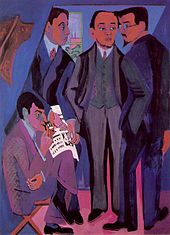
From 1893 the nationally important Great Berlin Art Exhibition took place every year. With the advent of the Berlin Secession in 1898, which shaped impressionism in painting, Berlin established itself as an outstanding center of the visual arts in Germany.
With the move of the Expressionist artist group "Brücke" to Berlin, the metropolis' art scene gained world renown. After 1933 and 1945, however, the connection to the international art world no longer succeeded.
It was only at the beginning of the 21st century that the city's importance for the visual arts increased again significantly. Since then, a large number of recognized artists have lived and worked in the city. The location within Germany also plays an important role on the art market due to the very high number of over 300 galleries in the international comparison .
literature
Numerous successful writers, philosophers, dramaturges, historians, critics, humorists and screenwriters live and work in Berlin. Some of the most recognized writers, past and present, include: Moses Mendelssohn , Wilhelm von Humboldt , Georg Wilhelm Friedrich Hegel , Theodor Mommsen , Georg Simmel , Alfred Kerr , Alfred Döblin , Christian Morgenstern , Joachim Ringelnatz , Kurt Tucholsky , Walter Benjamin , Bertolt Brecht , Vladimir Nabokov , Erich Kästner , Christopher Isherwood , Robert Jungk , Günter Grass , Heiner Müller , Christa Wolf , Wolfgang Kohlhaase , Heinrich August Winkler , Herta Müller , Max Goldt , Jonathan Franzen and Maxim Biller .
music





Since the development of Berlin into a metropolis of millions at the end of the 19th century, a large number of songs have emerged in pop culture that reflect the Berlin zeitgeist and life in the city.
One of the early pieces of music is Berliner Luft (1899), which is sometimes played as an unofficial national anthem . Other well-known songs include: Pack your swimming trunks (1951), homesickness for Kurfürstendamm (1963) and Berlin (1980).
The most successful artists, singers and bands who were born in Berlin or who have worked or are active for many years include, among others. Comedian Harmonists , Marlene Dietrich , Hildegard Knef , Conny Froboess , Rio Reiser , Gebrüder Blattuß , Ideal , City , Nina Hagen , Thomas Quasthoff , Tangerine Dream , Max Raabe , Harald Juhnke , Ton Steine Scherben , Reinhard Mey , Roland Kaiser , Helga Hahnemann , Frank Zander , Die Ärzte , Rammstein , Seeed , Bushido and Paul van Dyk .
International musicians such as Leonard Cohen , David Bowie , Iggy Pop , Lou Reed or the band U2 sang over Berlin or produced their albums in the city. The Hansa recording studios were an important point of contact for many artists to make their music recordings. Due to the large and varied music scene in Berlin, the metropolis is one of the most sung cities in the world.
See also
- List of the largest cities in the world (historical)
- List of the largest metropolitan areas in the world
- List of the largest cities in Europe
- List of the largest cities in the European Union
- List of megacities
- List of major cities in Germany
- List of sons and daughters of Berlin
- Berlin statistics
literature
sorted alphabetically by surname
- Udo Arnold : Prussia and Berlin. Relations between the province and the capital. Verlag Nordostdeutsches Kulturwerk, Lüneburg 1981, ISBN 3-922296-21-1 .
- Michael Bienert : Literary Berlin: 100 poets, writers and publicists; Places of residence, work and works. 3rd edition. Verlag Jena 1800, Berlin 2013, ISBN 978-3-931911-18-8 .
- Jens Bisky : Berlin. Biography of a great city. Rowohlt Berlin, Berlin 2019, ISBN 978-3-87134-814-3 .
- Horst Bosetzky , Jan Eik: The Berlin Lexicon. Jaron Verlag, Berlin 1998, ISBN 3-932202-57-0 .
- German Association of Architects and Engineers in Berlin-Brandenburg e. V. (Ed.): Unfinished Metropolis. Volume 1: 100 years of urban development for Greater Berlin. Volume 2: International Competition Berlin-Brandenburg 2070. View of Europe. Berlin 2020, ISBN 978-3-86922-241-7 .
- Christian Härtel : Berlin. A short story. In collaboration with the Bildarchiv Preußischer Kulturbesitz , bebra-Verlag, Berlin 2003, ISBN 3-89809-041-8 (English, Italian and Spanish editions).
- Jacob Hein: Instructions for use for Berlin. Completely revised new edition. Piper, Munich 2009, ISBN 978-3-492-27576-7 .
- Joachim Herrmann et al. (Ed.): Berlin. Results of the local history inventory (= values of our homeland . Vol. 49/50). Akademie-Verlag, Berlin 1987, ISBN 3-05-000379-0 .
- Wilhelm Heyne Verlag (ed.): The little book for the Berliner with heart and soul , with pictures by Michel Meyer, Verlag Wilhelm Heyne, Munich 1994, ISBN 3-453-08068-8 .
- Stefan Krätke: Berlin - city in the globalization process. In: Geographical Rundschau. 56 (4), 2004, ISSN 0016-7460 , pp. 20-25.
- Susanne Kähler : The symbolic interpretation of urban space - monument falls and iconoclasm in Berlin . In: Susanne Kähler, Wolfgang Krogel (Hrsg.): Yearbook of the Association for the History of Berlin (= Yearbook of the Association for the History of Berlin . Year 2020). tape 70 . Westkreuz-Verlag, 2020, ISSN 0522-0033 , p. 169-188 .
- Heinz Kullnick: Berliner and Berliner by choice . Persons and personalities in Berlin from 1640–1914. Hayn, Berlin 1961.
- Kurt Pomplun : Berlin houses - history and stories (= Berlin kaleidoscope. Vol. 14). 2nd edition Hessling, Berlin 1975, ISBN 3-7769-0119-5 .
- Wolfgang Ribbe (Ed.): History of Berlin. 2 vols. 3rd edition Berlin 2002 (publications of the Historical Commission in Berlin, standard work on the occasion of the 750th anniversary of Berlin).
- Bodo Rollka (ed.): Berlin biographical lexicon. 2nd edition Haude & Spener, 2003.
- Jutta Rosenkranz (Ed.): Berlin in poetry - poems from 250 years. 2nd edition, Husum Druck und Verlagsgesellschaft, Husum 2006, ISBN 3-89876-264-5 .
- Uwe Schaper (Ed.) In connection with the Landesarchiv Berlin: Berlinische Lebensbilder. Historical Commission to Berlin, Duncker & Humblot, Berlin 1987 ff. (Status 2015: 10 thematic individual volumes).
- Martin Wörner, Karl-Heinz Hüter, Paul Sigel and Doris Mollenschott (eds.): Architectural Guide Berlin. With an introduction by Wolfgang Schächen. 7th, revised and expanded edition. Reimer, Berlin 2013, ISBN 978-3-496-01380-8 .
- Reimer Wulf (photos), Karl Kessler (texts): Above the roofs of the New Berlin. Herbig, Munich 2004, ISBN 3-7766-2403-5 (aerial photo documentation).
Web links
|
Further content in the sister projects of Wikipedia:
|
||
|
|
Commons | - Media content (gallery) |
|
|
Wiktionary | - Dictionary entries |
|
|
Wikinews | - Messages |
|
|
Wikiquote | - Quotes |
|
|
Wikisource | - Sources and full texts |
|
|
Wikivoyage | - Travel Guide |
|
|
Wikidata | - knowledge database |
- Official website of the State of Berlin
- Official website of the Wir.Berlin brand
- Berlin bibliography
- Office for Statistics Berlin-Brandenburg
- 3D model of the Berlin city center
- Berlin on stadtpanoramen.de
- Berlin from A to Z - Luisenstädtischer Bildungsverein
Individual evidence
- ^ Office for Statistics Berlin-Brandenburg . Last accessed on June 22, 2020.
- ↑ Gross domestic product - at current prices - per inhabitant in Germany by federal state 1991 to 2015 ( Memento from June 26, 2015 in the Internet Archive ) (calculation status from August 2015 / February 2016). Statistical offices of the federal and state governments. Retrieved May 21, 2016.
- ↑ Preliminary state debt levels. Destatis , June 30, 2020, accessed November 12, 2020 . Provisional debt level of the federal states ( Memento of the original from November 18, 2020 in the Internet Archive ) Info: The archive link was inserted automatically and has not yet been checked. Please check the original and archive link according to the instructions and then remove this notice.
- ↑ a b c d Updated population figures from December 31, 2020 from the Berlin-Brandenburg Statistics Office ( [1] ) ( help on this ).
- ↑ a b Population in the State of Berlin Basic data on December 31, 2020. Office for Statistics Berlin-Brandenburg. Last accessed on February 11, 2021.
- ↑ Unemployment rates in November 2021 - countries and districts. In: statistik.arbeitsagentur.de. Statistics from the Federal Employment Agency, accessed on November 30, 2021 .
- ↑ Population development and population status in Berlin October 2020 , population development and population status in Brandenburg October 2020 , accessed on February 11, 2021.
- ^ Area of Berlin on December 31, 2012. Office for Statistics Berlin-Brandenburg.
- ↑ statistik-berlin-brandenburg.de (PDF)
- ↑ Berlin House of Representatives - Search for parliamentary groups. Retrieved January 18, 2019 .
- ↑ According to racist statements. Berlin AfD parliamentary group excludes Andreas Wild. ( Page no longer available , search in web archives ) Info: The link was automatically marked as defective. Please check the link according to the instructions and then remove this notice. In: rbb-online.de. June 18, 2017. Retrieved June 18, 2017.
- ↑ sth / dpa: Hitlerwein photos: AfD excludes Berlin deputies. In: Spiegel Online . November 6, 2018
- ^ Election to the House of Representatives on September 24, 2021 in Berlin. Wahlrecht.de, accessed on December 21, 2021 .
- ↑ Basic Law for the Federal Republic of Germany Art 22. In: gesetze-im-internet.de. Federal Ministry of Justice and Consumer Protection , accessed on January 10, 2017.
- ↑ Berlin is Europe's startup capital. W&V of January 21, 2016, accessed on March 3, 2017.
- ↑ Global Power City Index 2015 (PDF; 1.2 MB). Retrieved April 10, 2016.
- ↑ Revealed: Cities that rule the world - and those on the rise. In: CNN . accessed on April 14, 2010 (English).
- ↑ Leading cities in cultural globalizations / media. GaWC , accessed April 14, 2010.
- ^ Bernhard Meyer: Berlin - City of Nobel Prize Winners . In: Berlin monthly magazine ( Luisenstädtischer Bildungsverein ) . Issue 4, 2000, ISSN 0944-5560 , p. 58-64 ( luise-berlin.de ).
- ↑ London crowned as SportBusiness' 2012 Ultimate Sports City ( Memento of August 18, 2012 in the Internet Archive ). In: sportbusiness.com , accessed November 26, 2012.
- ↑ Tourism Report 2014. (PDF; 105 kB) (No longer available online.) IHK Berlin, February 2, 2015, archived from the original on September 6, 2015 ; accessed on April 18, 2019 . Tourism Report 2014 ( Memento of the original from September 6, 2015 in the Internet Archive ) Info: The archive link was inserted automatically and has not yet been checked. Please check the original and archive link according to the instructions and then remove this notice.
- ^ Berlin, the Big Canvas. In: The New York Times. Retrieved April 16, 2010.
- ↑ Environment portal of the city of Berlin: Water protection areas . Online at berlin.de . Retrieved July 31, 2019.
- ↑ Stefan Jacobs: The highest mountain in Berlin is recently in Pankow. In: tagesspiegel.de, February 22, 2015, accessed on May 12, 2016.
- ↑ A mushroom breaks plane trees. In: Berliner Zeitung , November 15, 2008, p. 19.
- ↑ C. Kress: The residential area at the Botanical Garden; Forms of living and urban development models before and after the First World War. In: Adolf Sommerfeld - Andrew Sommerfield: Building for Berlin 1910-1970. Lukas Verlag, 2011, ISBN 978-3-86732-081-8 .
- ↑ Nature reserves, overview. Senate Department for Urban Development Berlin, accessed on July 30, 2018.
- ↑ Protected areas. Senate Department for Urban Development Berlin, accessed on May 16, 2010.
- ↑ The transnational Barnim Nature Park. Senate Department for Urban Development Berlin. Retrieved May 16, 2010.
- ^ GISS Surface Temperature Analysis, Station Data: Berlin-Tempelhof. National Aeronautics and Space Administration, Goddard Institute for Space Studies (English).
- ↑ GISS Surface Temperature Analysis (v4), Station Data: Berlin Tempelhof. National Aeronautics and Space Administration, Goddard Institute for Space Studies (English).
- ↑ Stefan Jakobs: Weather service is looking for a new place for a measuring station in Berlin. In: www.tagesspiegel.de. Der Tagesspiegel, December 13, 2020, accessed on May 14, 2021 .
- ↑ mean temperatures from 1981 to 2010 from the DWD ( memento from July 17, 2013 in the web archive archive.today ), mean precipitation from 1981 to 2010 from the DWD ( memento from June 1, 2013 in the web archive archive.today )
- ↑ Climate information Berlin. World Meteorological Organization, accessed January 4, 2013 .
- ↑ Berlin Environmental Atlas, 1993/2001 ( Memento from August 18, 2017 in the Internet Archive ). (PDF; 94 kB) Senate Department for Urban Development, accessed on April 16, 2010.
- ↑ Berlin Environmental Atlas, 2008. Senate Department for Urban Development, accessed on April 16, 2010.
- ↑ City trees: overviews of the existing data. Senate Department for Urban Development, accessed on April 16, 2010.
- ↑ General Law of Responsibility AZG Berlin, § 9 Law on Responsibilities in the General Berlin Administration (General Law of Responsibility - AZG) ( Memento of July 25, 2013 in the Internet Archive ) (PDF; 224 kB). Retrieved April 16, 2010.
- ↑ Survey - The Berlin administration does poorly in a European comparison. In: Berliner Zeitung . April 14, 2016. Retrieved August 13, 2016.
- ↑ Andreas R. Becher: Put an end to the downtime in residential construction! In: Der Tagesspiegel , July 25, 2017, accessed on August 25, 2017.
- ^ Greater Berlin Act . Luisenstadt educational association
- ↑ Residents in the State of Berlin on December 31, 2020, data from the Berlin-Brandenburg Statistics Office , accessed on February 11, 2021 ( PDF file ) ( help on this ).
- ↑ a b German book of place names. Edited by Manfred Niemeyer . Walter de Gruyter, Berlin / Boston 2012, ISBN 978-3-11-018908-7 , p. 60.
- ^ Arnt Cobbers: Little Berlin story. From the Middle Ages to the present . 2nd updated edition. Jaron Verlag, Berlin 2008, ISBN 978-3-89773-142-4 , p. 14 .
- ↑ Herbert Schwenk: On the origin of the names of the twin cities "Berlin" and "Cölln". (No longer available online.) In: luise-berlin.de. Luisenstädtischer Bildungsverein , July 1, 2007, archived from the original on January 1, 2015 ; Retrieved on April 18, 2019 (from: Herbert Schwenk: Berliner Stadtentwicklung von A – Z. Edition Luisenstadt, Berlin 1997).
- ^ HG Gengler: Regesta and documents on the constitutional and legal history of German cities in the Middle Ages. Erlangen 1863, pp. 181-196 .
- ↑ The German capital is aging by decades. In: Welt Online , October 18, 2012.
- ↑ Wolfgang Ribbe (Ed.): History of Berlin. 3rd edition Berlin 2002, pp. 182, 268-271.
- ↑ Berlin's unwillingness. In: diegeschichteberlins.de. Association for the History of Berlin e. V., accessed May 30, 2013.
- ↑ What aroused the "Berlin displeasure". In: Tagesspiegel Online . October 26, 2012.
- ↑ Bernd Horlemann (ed.), Hans-Jürgen Mende (ed.): Berlin 1994. Pocket calendar. Edition Luisenstadt Berlin, No. 01280.
- ↑ a b c d e Wolfgang Ribbe, Jürgen Schmädeke: Reform time, revolution and reaction (1800 to 1860). The end of the Frederician era: Berlin in a phase of upheaval. In: A Little Berlin Story. Published by the State Center for Political Education in Berlin in conjunction with the Historical Commission in Berlin, Stapp Verlag, Berlin 1994, ISBN 3-87776-222-0 , pp. 80–128.
- ↑ Brigitte Beier: The Chronicle of the Germans. Gütersloh and Munich 2007, p. 198.
- ↑ Calendar sheet May 28 in: Nordbayerischer Kurier from May 28, 2019, p. 2.
- ↑ Axel Weipert: The Red Berlin. A history of the Berlin labor movement 1830–1934. Berliner Wissenschafts-Verlag, Berlin 2013, ISBN 978-3-8305-3242-2 .
- ^ Robert Springer: Berlins streets, pubs and clubs in the year 1848. Verlag Friedrich Gerhard, Berlin 1850, DNB 207078831 (reprint).
- ↑ Horst Ulrich, Uwe Prell, Ernst Luuk: Berlin Handbook. The lexicon of the federal capital. FAB Verlag, Berlin 1992, ISBN 3-927551-27-9 , p. 557 (Hobrechtplan), 818 f. (Tenements), 1388 f. (Housing).
- ↑ For the constitutional status see: German Reich # Constitutional questions after 1945 .
- ↑ Axel Weipert: The Red Berlin. A history of the Berlin labor movement 1830–1934. Berliner Wissenschafts-Verlag, Berlin 2013, ISBN 978-3-8305-3242-2 , pp. 138-162.
- ↑ Birgitt Eltzel: "Shooting order for Lichtenberg" - LiMa +. In: lichtenbergmarzahnplus.de. February 28, 2019, accessed May 6, 2019 . "Shooting order for Lichtenberg" - LiMa + ( Memento of the original from May 6, 2019 in the Internet Archive ) Info: The archive link has been inserted automatically and has not yet been checked. Please check the original and archive link according to the instructions and then remove this notice.
- ↑ Nicola Schwannauer: Tinkerer Zaschka: a Freiburg native who got everything small. In: Badische Zeitung . May 15, 2016. Retrieved April 3, 2017 .
- ↑ YouTube video about Engelbert Zaschka. SWR television, May 16, 2016, accessed on November 6, 2016 .
- ^ Matthias Donath: Bunker, Banks, Reich Chancellery - Architectural Guide Berlin 1933–1945. Lukas, Berlin 2005, ISBN 3-936872-51-1 .
- ↑ Memorial Book. Search in the name directory. Search for: Berlin - residence. In: bundesarchiv.de, accessed on August 17, 2017.
- ^ Johannes Strempel: Berlin. End in ruins. In: GEO epoch . No. 44, Hamburg 2010, pp. 146–162, here p. 162.
- ^ A great day in the history of our city , Press and Information Office of the State of Berlin 1963, brochure printed in the Tempelhof printing house
- ↑ Treaty between the Federal Republic of Germany and the German Democratic Republic on the establishment of the unity of Germany - excerpt (PDF; 56 kB) on berlin.de, accessed on May 31, 2013.
- ↑ Completion of the unity of Germany (PDF; 213 kB) German Bundestag, 12th electoral period, 1991, on berlin.de, accessed on May 31, 2013.
- ↑ Statistics on European cities. ( Memento of August 3, 2016 in the Internet Archive ) Eurostat , archived by archive.org on August 3, 2016.
-
↑ Rounded numbers, compiled from:
Wolfgang Ribbe (Ed.): Geschichte Berlins. Volume II. From the March Revolution to the Present. C. H. Beck, Munich 1987, pp. 692-697.
Otto-Friedrich Gandert, Berthold Schulze, Ernst Kaeber and others (eds.): Heimatchronik Berlin. Archive for German home care, Cologne 1962, p. 427.
Max Mechow: The East and West Prussians in Berlin. A contribution to the population history of the city. Haude & Spener, Berlin 1975, pp. 112/113.
Royal Statistical Bureau (ed.): Statistical manual for the Prussian state. Publishing house of the royal statistical bureau, Berlin 1898, on the mother tongue pp. 128/129, on the proportion of foreigners pp. 114/115. - ↑ Berlin between baroque and modern. In: Berliner Morgenpost , accessed on October 12, 2018.
- ↑ Statistical Yearbook 2011 (PDF; 3.9 MB) statistik-berlin-brandenburg.de. Retrieved July 2, 2012.
- ↑ go to "Journal for Official Statistics Berlin-Brandenburg, Edition (5/2012)", there p. 25 (document page 27)
- ↑ a b Big city without megalomania . In: The mirror . No. 12 , 2007, p. 22-38 ( Online - Mar. 19, 2007 ).
- ↑ Spatial population movement. (No longer available online.) In: statistik-berlin-brandenburg.de. Office for Statistics Berlin-Brandenburg , archived from the original on November 4, 2015 ; accessed on April 18, 2019 (population: November 30, 2013): "Berlin and Brandenburg: across the border of the region, without migrations between Berlin and Brandenburg"
- ↑ Statistical report AI 5 - hj 2/20 residents in the State of Berlin on December 31, 2020 (PDF) Office for Statistics Berlin-Brandenburg, 2021, accessed on March 2, 2021 .
- ↑ Statistics Berlin-Brandenburg, Table 01.33 (PDF; 664 kB).
- ↑ 35 percent of Berliners have a migration background . In: Der Tagesspiegel
- ^ Office for Statistics Berlin Brandenburg - Statistics. Retrieved November 11, 2020 .
- ↑ Statistical report AI 5 - hj 1/17 - residents in the state of Berlin on June 30, 2017. List of 10 foreign residents in Berlin on June 30, 2017 by country of citizenship, gender and age group .
- ↑ Young EU academics are drawn to Berlin. At: Rundfunk Berlin-Brandenburg , October 29, 2015.
- ^ Report from the Office for Statistics Berlin-Brandenburg as of December 31, 2010.
- ^ Initiative Black People in Germany , Yonis Ayeh: ISD Online . Isdonline.de. Retrieved September 15, 2011.
- ↑ Berlin wants to help illegal immigrants. In: Der Tagesspiegel , February 23, 2009.
- ↑ Susanne Memarnia: Admission of refugees at sea: Berlin finally wants to become a port . In: The daily newspaper . June 14, 2019, ISSN 0931-9085 ( taz.de [accessed on September 18, 2019]).
- ↑ Church members and non-denominational in Berlin, 1867–2017. Table 2.2. Research Group Weltanschauungen in Germany, a project of the Giordano Bruno Foundation , March 18, 2019, accessed on February 17, 2021.
- ↑ 2011 census.
- ↑ Census 2011 - facts about the population in Germany. ( XLS ; 2.0 MB) Press conference on May 31, 2013 in Berlin. (No longer available online.) In: destatis.de. Federal Statistical Office , May 31, 2013, archived from the original on November 14, 2013 ; accessed on May 31, 2019 (table material: “Selected socio-demographic data (employment, education, migration, religion)”, table 9, entry “Berlin”).
- ↑ Map page: Muslims in the major cities in the 2011 census. (PDF) March 27, 2017, accessed on June 30, 2020 .
- ↑ Statistical Yearbook Berlin 2013 (PDF; 500 kB) Retrieved on June 30, 2020 .
- ↑ Sonja Haug, Stephanie Müssig, Anja Stichs: Muslim Life in Germany . on behalf of the German Islam Conference. Ed .: Federal Office for Migration and Refugees (= research report . Volume 6 ). 1st edition. Nuremberg 2009, ISBN 978-3-9812115-1-1 , p. 107 ( bamf.de [PDF; 5.9 MB ; accessed on June 30, 2020]).
- ↑ Statistical report - residents by religion on December 31, 2020 (PDF; 1.1 MB) Statistics Berlin Brandenburg, p. 37, accessed on February 17, 2021.
- ↑ Statistical report - residents by religion on December 31, 2019 (PDF; 3.5 MB) Statistics Berlin Brandenburg, p. 37, accessed on June 22, 2020.
- ↑ Study on Islamic Congregational Life . ( Memento from December 11, 2018 in the Internet Archive ) In: rbb24 . July 16, 2018, accessed July 31, 2018.
- ↑ Statistical Yearbook for Berlin 2015, (PDF) accessed on June 17, 2016 (PDF; 583 kB).
- ↑ The number of students increases. In: humanistische.de. April 10/2. May 2017. Retrieved August 25, 2017.
- ↑ Answer to the written question of the MP Hakan Taş (Die Linke): Religious or ideological instruction in accordance with Section 13 of the School Act at Berlin Schools. (PDF; 127 kB) Drs. 17/15795, accessed on April 27, 2015.
- ^ Church district Berlin-Brandenburg. In: lutherisch-in-berlin.de, accessed on October 2, 2021.
- ↑ St. George's Congregation website. Retrieved February 17, 2021.
- ↑ Old Catholics / Berlin community. ( Memento from November 27, 2009 in the Internet Archive ) In: alt-katholisch.de, accessed on April 16, 2010.
- ↑ a b Alt-Katholiken / Gemeinde Berlin , accessed on July 8, 2014.
- ↑ Study: There are almost 100 mosques and prayer rooms in Berlin . In: Berliner Morgenpost , accessed on July 31, 2018.
- ↑ Stefan Strauss: Berlin-Neukölln: The time for Germany's largest Hindu temple is running out. In: Berliner Zeitung. March 11, 2017, accessed March 11, 2021 .
- ↑ (dpa): New BND headquarters in Berlin: This is how the secret move went. In: morgenpost.de, November 29, 2018, accessed on December 17, 2021.
- ↑ dpa / bar: Are all ministries moving to Berlin now? In: Die Welt, October 6, 2015, accessed on October 8, 2015.
- ^ Peter Gassner: Bonn / Berlin law: Bonn quota drops below a third. In: General-Anzeiger . January 12, 2018. Retrieved January 24, 2018.
- ↑ Diplomatic Berlin ( Memento from July 22, 2012 in the Internet Archive ). In: magazin-deutschland.de, November 26, 2007, accessed on May 19, 2010 (English).
- ↑ Doug Saunders: All roads lead to Berlin ( Memento from August 25, 2013 in the Internet Archive ). In: The Globe and Mail . June 23, 2012, accessed August 13, 2012.
- ↑ Federal Law Gazette
- ^ A minor exception was the possibility, which existed until 1961, of bringing people living in East Berlin, i.e. GDR citizens according to the GDR reading, to the German Bundestag via a state list of a West German party selected by the Berlin House of Representatives , including Kurt Neubauer and Margarete Berger-Heise made use of it.
- ↑ Federal Ministry of Justice and Consumer Protection, juris GmbH (ed.): Treaty between the Federal Republic of Germany and the German Democratic Republic on the establishment of the unity of Germany (Unification Treaty) - Art 3 entry into force of the Basic Law . ( gesetze-im-internet.de [accessed on May 31, 2017]).
- ↑ Berlin's political landscapes In: TSP, accessed on October 21, 2021, interactive
- ↑ Senate Department Finance (PDF; 581 kB) Berlin.de, accessed on July 10, 2013.
- ↑ Debt of the federal states in Germany on June 30, 2018. Accessed November 30, 2018
- ↑ State financial equalization and federal supplementary allocations . bpb.de, June 11, 2014.
- ↑ European Structural Funds 2014–2020 in Berlin Berlin.de, accessed on August 14, 2016.
- ↑ Manfred Schäfers: Bavaria pays more than half. In: FAZ , January 21, 2018
- ↑ town twinning
- ↑ Berlin.de , accessed on November 21, 2012.
- ↑ Wolfgang Hornung-Arnegg: Fire Department History . 4th edition Kohlhammer, 1995, ISBN 3-17-013203-2 , p. 61.
- ↑ Annual report of the Berlin fire brigade 2016. P. 82. - Annual reports . Online at: berliner-feuerwehr.de, accessed on August 17, 2017.
- ↑ a b c For comparison: 3922 positions, 35 fire stations, 1357 volunteers (as of December 2014). In: Annual Report of the Berlin Fire Brigade 2014, p. 83 f.
- ↑ Gross domestic product of Berlin until 2019. Accessed on July 18, 2020 .
- ↑ Economic performance . June 9, 2020, accessed July 18, 2020 .
- ↑ Employed people. Retrieved July 18, 2020 .
- ↑ a b Erik Peter: Berlin and its millionaires: The city of the rich . In: The daily newspaper . September 19, 2020, ISSN 0931-9085 ( taz.de [accessed January 25, 2021]).
- ↑ Wealth in Berlin: Berlin's millionaires live here . In: Berliner Zeitung . Retrieved January 22, 2021 .
- ↑ Global Power City Index 2011 (PDF; 1.3 MB), accessed on July 3, 2013.
- ↑ Berlin Economy in Figures 2012 ( Memento from November 1, 2012 in the Internet Archive ). (PDF; 7.4 MB) IHK-Berlin, August 24, 2012, accessed on September 4, 2012.
- ↑ Quality of Living Ranking 2016. In: mercer.com. February 23, 2016, accessed December 19, 2016 .
- ^ The Wealth Report. A Global Perspective on Prime Property and Wealth 2011 ( Memento from July 1, 2011 in the Internet Archive ). In: knightfrank.com, accessed on August 25, 2017 (PDF; 19.3 MB).
- ↑ Monocle Quality of Life Survey (video) , accessed February 24, 2015.
- ^ Cushman & Wakefield Romania S. R. L .: European Cities Monitor 2011 ( Memento of April 8, 2013 in the Internet Archive ). In: oldrbd.doingbusiness.ro. October 21, 2011 (English) Retrieved July 14, 2017.
- ↑ Berlin is the capital of the shortage of skilled workers . In: Der Tagesspiegel , accessed on February 9, 2016.
- ↑ Future Atlas 2016. (No longer available online.) Archived from the original on October 2, 2017 ; accessed on March 23, 2018 .
- ↑ Berlin-based companies Hello Fresh and Zalando move up in the DAX. In: rbb24.de. September 4, 2021, accessed December 21, 2021 .
- ↑ Why Siemens Energy is relocating its corporate headquarters to Berlin. Retrieved July 23, 2021 .
- ↑ Fortune Global 500, accessed August 12, 2020.
- ↑ MDAX list | MDAX values | MDAX shares. Retrieved August 12, 2020 .
- ↑ SDAX list | SDAX values | SDAX shares. Retrieved August 12, 2020 .
- ↑ Berlin is the metropolis of the daring. In: Berliner Morgenpost , accessed on July 14, 2017.
- ↑ Silicon Valley is no longer # 1 for talent says huge global startup report. In: The Next Web , accessed July 14, 2017.
- ↑ Pauline Schnor 18 Jun 2020: "Corona threatens our existence", say 80 percent of Berlin startups. June 18, 2020, accessed January 20, 2021 .
- ↑ Ranking: This is how the 10 largest employers in Berlin perform. In: kununu.com. January 22, 2020, accessed January 20, 2021 .
- ↑ General Electric cuts 1,600 jobs: Berlin plant is closed. In: bz-berlin.de. December 7, 2017, accessed June 17, 2021 .
- ↑ manager magazin: Philip Morris closes cigarette factory in Berlin. Retrieved June 17, 2021 .
- ↑ 2,000 layoffs: Daimler employees appalled at the quasi-closure of the Berlin plant. In: bw24.de. November 13, 2020, accessed June 17, 2021 .
- ↑ 750 employees affected: Samsung closes the Berlin picture tube factory. Retrieved August 3, 2021 .
- ↑ Millions of dollars and invisible. In: tagesspiegel.de. Retrieved June 17, 2021 .
- ↑ Senate Department for Economics, Energy and Enterprises , Department of Economics: Berlin Tourism in Figures with data from the Berlin-Brandenburg Statistics Office, accessed on February 27, 2018
- ^ Office for Statistics Berlin-Brandenburg , status: 2016, accessed on May 21, 2016.
- ↑ Tourism concept of the city of Berlin. Framework for action 2011+ ( Memento from October 28, 2012 in the Internet Archive ) (PDF; 3.4 MB). In: service-in-the-city.de, accessed on September 20, 2012.
- ↑ Tourism as an economic factor. (PDF; 2.7 MB) (No longer available online.) In: berlin.de. 2009, archived from the original on October 13, 2012 ; accessed on April 25, 2018 (IHK Berlin).
- ↑ Congress country Austria still at the forefront. In: Tourismuspresse.at. Press release, October 3, 2011, accessed May 6, 2012.
- ↑ Exhibition and congress location. ( Memento of August 11, 2012 in the Internet Archive ) Business Location Center, press release, accessed on August 13, 2012.
- ^ Health economy in Berlin. (No longer available online.) In: ihk-berlin.de. IHK Berlin , January 2012, archived from the original on February 13, 2013 ; accessed on April 18, 2019 : “Own illustration based on Hilbert et al. 2002 “ Health economy in Berlin ( Memento of the original from February 13, 2013 in the Internet Archive ) Info: The archive link was inserted automatically and has not yet been checked. Please check the original and archive link according to the instructions and then remove this notice.
- ↑ Berlin clusters in numbers. (No longer available online.) In: ihk-berlin.de. 2012, archived from the original on February 13, 2013 ; accessed on April 18, 2019 . Berlin clusters in figures ( Memento of the original from February 13, 2013 in the Internet Archive ) Info: The archive link has been inserted automatically and has not yet been checked. Please check the original and archive link according to the instructions and then remove this notice.
- ↑ BioTop Report 2010 . (PDF; 8.8 MB), accessed on August 9, 2012.
- ^ Competence field biotechnology at the Senate Department for Economics, Technology and Research ( Memento from December 22, 2013 in the Internet Archive ). In: berlin.de, accessed on August 9, 2012.
- ↑ Economic and Innovation Report Berlin Berlin.de, October 3, 2018.
- ↑ 2500 companies, more than 22,000 employees - the industry is booming. A summary of the Fashion Week. In: Berliner Morgenpost . 22nd January 2017.
- ↑ Record amount for German start-ups - Berlin is Europe's start-up capital, ( Memento of the original from April 4, 2017 in the Internet Archive ) Info: The archive link has been inserted automatically and has not yet been checked. Please check the original and archive link according to the instructions and then remove this notice. accessed on March 15, 2016.
- ↑ News agencies and press agencies , Berlin.de, accessed on April 28, 2018.
- ↑ Statista: Ranking of the cities with the most publishers in Germany in 2016 , according to data from the Börsenverein
- ↑ The World's 50 Largest Publishers, 2017. In: Publishers Weekly , accessed April 28, 2018.
- ↑ These are the 10 most important media cities. At : agraphwirtschaft.de , accessed on April 28, 2018.
- ↑ Annual balance sheet of the Berlin industry: sales almost unchanged (PDF), Office for Statistics Berlin-Brandenburg, accessed on May 11, 2018.
- ↑ Corinna Visser: The turbines turn more slowly. In: Der Tagesspiegel . December 20, 2012, accessed April 6, 2018 .
- ↑ The BMW plant in Berlin at a glance . In: bmw-werk-berlin.de , accessed on August 18, 2018.
- ↑ Europe's retail centers ranked , CoStar, accessed in August 2018.
- ↑ Top 25 Most Attractive European Retail Destinations , Europe Real Estate, accessed August 9, 2018.
- ↑ The capital is bursting at the seams. In: Der Tagesspiegel . June 2, 2014, accessed March 15, 2018.
- ^ A b German Federal Government: Money laundering in the real estate sector, printed matter 19/2449 . In: German Bundestag (ed.): Small inquiry . June 2018 ( bundestag.de [PDF]).
- ↑ Berlin and Munich are the most expensive investment locations in Germany. In: Immobilien Zeitung . January 11, 2017. Retrieved March 15, 2018.
- ↑ New rentals remain without the rental price brake. Retrieved February 17, 2021 .
- ^ Berlin Stock Exchange. At: Berlin.de , accessed on August 9, 2018.
- ↑ Venture capital between local proximity and the new pull of Berlin. (PDF; 536 kB) In: nationalatlas.de, accessed on January 23, 2018.
- ↑ Accessibility in the areas of transport and construction , Senate Department for Social Affairs, accessed on May 16, 2010.
- ↑ Claudius Prößer: It is high time for a turning point . In: The daily newspaper: taz . May 25, 2019, ISSN 0931-9085 , p. 41, 44–45 ( taz.de [accessed July 5, 2019]).
- ↑ Thomas Fülling: BVG bus fleet will be electrified by 2030. After a visit to China, Transport Senator Regine Günther and BVG boss Sigrid Nikutta see this task as big, but solvable. In: morgenpost.de . September 11, 2018, accessed July 6, 2019 .
- ↑ a b Figures on taxi and rental car traffic. (PDF; 926 kB) (No longer available online.) Deutscher Taxi- und Autovermietungverband e. V. (BZP), October 22, 2015, archived from the original on April 17, 2016 ; accessed on May 2, 2016 . Figures on taxi and rental car traffic ( Memento of the original from April 17, 2016 in the Internet Archive ) Info: The archive link was inserted automatically and has not yet been checked. Please check the original and archive link according to the instructions and then remove this notice.
- ↑ Info: Taxi trade in Berlin. In: Berliner Morgenpost. January 19, 2012. Retrieved February 15, 2012 .
- ↑ Income tax law: taxi trade: appraisal and designation requests. In: Judgment of the Third Senate, 3 K 13/09. Finanzgericht Hamburg , September 7, 2010, accessed on March 31, 2012 : "In Hamburg, like in Berlin, but in contrast to all other German municipalities, the number of taxi concessions is not limited."
- ↑ Press release of the Federal Statistical Office of September 11, 2020
- ↑ Federal government pays for the A 100 . In: Berliner Zeitung . November 28, 2012.
- ↑ a b Cycling Strategy 2013 (PDF) of the Senate Department for Urban Development and the Environment (PDF; 556 kB).
- ↑ Key data on mobility (2008). (PDF) Senate Department for Urban Development, accessed on November 8, 2012.
- ↑ Berliners drive less cars. In: Der Tagesspiegel , April 17, 2009.
- ↑ Berlin's fight against the car. In: Berliner Kurier . April 11, 2014.
- ↑ Traffic report December 2016 . Berlin Brandenburg Airport GmbH. January 12, 2017. Retrieved January 12, 2017.
- ↑ "The commissioning of BER has never been so safe". Retrieved April 29, 2020 .
- ^ Office for Statistics Berlin-Brandenburg - Road Traffic. Accessed on January 19, 2013.
- ^ Berlin has 564 bridges. In: Berliner Morgenpost , accessed on May 16, 2010.
- ↑ rise in groundwater. In: stadtentwicklung.berlin.de. Senate Department for Health, Environment and Consumer Protection, accessed on November 12, 2011 .
- ↑ Wasserwerke , Berliner Wasserbetriebe, accessed on May 12, 2021.
- ↑ Wastewater disposal. (No longer available online.) In: Berlin.de, the official capital city portal. Umweltportal - a cooperation between the Berlin environmental agencies, the Senate Department for Health, Environment and Consumer Protection and the Senate Department for Urban Development, archived from the original on February 13, 2011 ; Retrieved February 13, 2011 .
- ↑ The sewer network. (No longer available online.) In: bwb.de. Berliner Wasserbetriebe, archived from the original on April 18, 2011 ; Retrieved April 18, 2011 .
- ↑ Climate-neutral Berlin. Berliner Stadtwerke, accessed on November 26, 2019 .
- ↑ Berlin is buying back the power grid for 2.18 billion euros. In: Berliner Morgenpost , accessed on May 13, 2021.
- ↑ Share of energy sources in net electricity generation in Germany by federal state in 2009. From : Statista , accessed on August 3.
- ↑ Berlin House of Representatives (ed.): Communication - for information - termination of coal use in Berlin . Printed matter 18/1203. Berlin June 28, 2018.
- ↑ Ulrike Kiefer: Retired at 50: Unit C in the Reuter power plant goes offline. In: Spandauer Volksblatt . FUNKE Berlin Wochenblatt GmbH, October 7, 2019, accessed on August 6, 2021 .
- ↑ Berlin House of Representatives (ed.): Communication - for information - termination of coal use in Berlin . Printed matter 18/3907. Berlin May 25, 2021.
- ↑ Berlin introduces compulsory solar power. In: The mirror . June 17, 2021, accessed August 6, 2021 .
- ↑ Now it's turning 13: New wind farm in Albertshof connected to the grid. Berliner Stadtwerke, March 10, 2021, accessed on August 6, 2021 .
- ↑ Energy and CO 2 balance in Berlin 2010. (PDF; 476 kB) Office for Statistics Berlin-Brandenburg, p. 13, accessed on August 2, 2013.
- ↑ Energy and CO 2 balance in Berlin 2010. (PDF; 476 kB) Office for Statistics Berlin-Brandenburg, p. 15, accessed on August 2, 2013.
- ↑ Energy and CO 2 balance in Berlin 2010 (PDF; 476 kB). Statistics Office Berlin-Brandenburg, p. 26, accessed on August 2, 2013.
- ^ Mapping the World's Knowledge Hubs, Richard Florida - Citylab.com, accessed July 11, 2017.
- ↑ That's why young people from all over the world come to Berlin. In: Berliner Zeitung , accessed on July 11, 2017.
- ↑ The world's best student cities, UNICUM, accessed July 11, 2017.
- ↑ Nobel Prize Winner. In: hu-berlin.de, accessed on December 2, 2011.
- ↑ Density - Diversity - Excellence . berlin-sciences.com. Archived from the original on August 25, 2012. Retrieved on August 21, 2012.
- ↑ Decisions in the second program phase of the Excellence Initiative. Press release No. 26. In: dfg.de. June 15, 2012. Retrieved August 21, 2012 .
- ↑ Excellence initiative for cutting-edge research at universities. In: bmbf.de. August 15, 2012. Retrieved August 21, 2012 .
- ^ Tilmann Warnecke: Berlin now has two elite universities. In: Der Tagesspiegel . June 15, 2012. Retrieved August 21, 2012 .
- ↑ Excellence Strategy. Berlin University Alliance, accessed June 27, 2020 .
- ↑ Decisions in the Excellence Strategy: The Excellence Commission selects ten Excellence Universities and one Excellence Network. DFG - German Research Foundation, accessed on June 27, 2020 .
- ↑ Excellence Strategy. State of Berlin, accessed on June 27, 2020 .
- ↑ Best International Business Schools 2016 , Bloomberg Businessweek, accessed July 11, 2017.
- ↑ DFG presents "Funding Atlas 2012": Competition for third-party funding as "a matter of course". Press release No. 24. In: dfg.de. May 24, 2012. Retrieved August 21, 2012 .
- ↑ Berlin, before Munich, is the most research-intensive German region. In: focus.de. German Press Agency , May 24, 2012, accessed on August 21, 2012 .
- ↑ List of the MPG's corporate sponsors ( Memento from January 14, 2011 in the Internet Archive ; PDF; 445 kB)
- ↑ Berlin becomes the world capital of mathematics. IDW; accessed on August 1, 2018.
- ↑ From the beginning of August, the daycare fee will not apply , Tagesspiegel, accessed on December 9, 2017.
- ↑ Day care study criticizes lack of educators in Berlin. In: Berliner Zeitung .
- ↑ statistik-berlin-brandenburg.de School statistics 2016/17, Office for Statistics Berlin Brandenburg, accessed on December 9, 2017.
- ↑ Legal text
- ↑ Education statistics 2016 , HWK-Berlin, accessed on December 9, 2017.
- ↑ Press release No. 161 of July 5, 2017 (PDF), Office for Statistics Berlin Brandenburg, accessed on December 9, 2017.
- ↑ Annual Report 2014 Berlin Public Libraries for the Future, Jahresbericht_voebb_2014.pdf, accessed on July 27, 2018.
- ↑ Global Power City Index (English; PDF; 2.1 MB), Institute for Urban Strategies Tokyo on October 22, 2009, accessed on April 16, 2010.
- ^ In Berlin, Artists Find a Home. In: The New York Times , April 24, 2018, accessed August 1, 2018.
- ↑ World Heritage Site Museum Island. UNESCO, accessed April 16, 2010.
- ^ Architect Paul Baumgarten (1900–1984). In: bundestag.de, accessed on November 3, 2021.
- ^ Clubs and associations. In: berlin.de. Senate Department for Home Affairs and Sport, 2018, accessed on April 24, 2018 .
- ↑ Bundesliga teams , lsb-berlin.net, accessed on November 8, 2017.
- ^ German volleyball league. Retrieved May 2, 2016 .
- ↑ Bolt wins gold and world record. In: Spiegel Online , accessed November 8, 2017.
- ↑ Olympic Base Berlin - Base - Sports. In: osp-berlin.de. Sponsoring Association of the Olympic Training Center Berlin e. V., accessed June 8, 2017 .
- ↑ Numbers and facts about the Berlin Olympic Stadium ( Memento from August 15, 2012 in the Internet Archive ). In: olympiastadion-berlin.de, accessed on May 17, 2014.
- ↑ The happy bread at FEZ Wuhlheide , accessed on August 12, 2014.
- ↑ World's best nightlife cities , CNN, accessed July 10, 2018.
- ↑ Restaurants in Berlin , Berlin.de, accessed on August 21, 2018.
- ↑ MICHELIN Guide Germany Berlin Restaurants
- ↑ Rich but unsexy . At: Spiegel Online ; accessed on August 14, 2018.
- ↑ Berlin is the city with the most galleries in the world. In: Berliner Morgenpost , April 6, 2008, accessed on January 1, 2018.
- ↑ Michael Bienert : Literary Berlin - 100 poets, writers and publicists - places of residence, work and works , Verlag Jena 1800, Berlin 2013, ISBN 978-3-931911-18-8
- ↑ The Berlin song is really booming. In: Die Welt , accessed on May 16, 2010.
- ^ Johannes Koepp, Wilhelm Cleff: Dear organ grinder. Berlin songs. Nicolaische Verlagsbuchhandlung, Berlin 2015, ISBN 978-3-89479-920-5 .
- ↑ The World's Most Sung-Sung Cities , Der Standard, accessed May 11, 2021.

